Owls are birds that occur in almost every part of the world, except Antarctica. They belong to the order Strigiformes. Like other birds of prey, owls also have to kill other animals to feed themselves. Most of the owls hunt small mammals but strangely enough, few species are expert fish-hunters too. Since there are many types of owls out there, people often wonder what do owls eat in the wild and in captivity?
But when it comes to owl eating habits, perhaps some of the important factors that may determine the owl diet are its size, habitat and the particular kind of species. Generally, owls are nocturnal birds but there are several crepuscular species too.
Owls mainly eat mammals (like mice, moles, rats, lemmings, squirrels, rabbits, shrews and gophers), amphibians (like frogs, salamanders), reptiles (like lizards, snakes), insects (like crickets, caterpillars, moths and beetles). They also eat birds and fish. Owl diet depends upon its species.
There are around 216 different species of owls in the world. Out of these, 18 species are from the family of Barn Owl while the rest belong to the True Owl family.
Elf owl, being the smallest, largely feeds on insects while the great gray owl, being one of the world’s largest owls, mainly eats small mammals like rodents. Thus, not only is there a great deal of diversity in the size and appearance of owls but the owl diet as well as the owl hunting habits also vary considerably.
Thus, what kind of food do owls eat depends a great deal on the particular size and owl species. Perhaps some of the favorite prey items of most medium to large sized owls appear to be small mammals like rats, mice, squirrels and rabbits, among others.
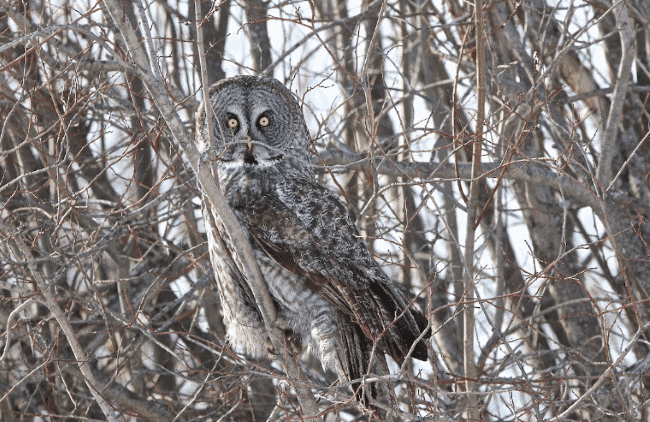
Great Gray Owl
Fort McMurray, Alberta, Canada
Photo © Bob Bidney/Macaulay Library at the Cornell Lab
Now, we are going to learn all about owls by examining prey items that are usually consumed by common owls, along with the pictures of different types of owls. However, before diving right in, first let’s explore the hunting and feeding strategies of owls.
Different Types of Owls: Owl Adaptations for Hunting
Table of Contents
How Do Owls Hunt their Prey?

Snowy Owl – Photo © Tony Hisgett
- Owls are opportunistic predators and efficient hunters.
- With the help of acute hearing and keen eyesight, owls tend to detect their prey at dawn, dusk and even at night.
- Owls can also discriminate different sounds of prey by memorizing them. Barn owl, for instance, has the most accurate ability to locate its prey, thus allowing the bird to capture the animal that may be hidden under vegetation.
- In order to hunt their prey, some owls like snowy owls tend to use different hunting strategies like perch-and-scan and hover-and-scan, followed by a sudden dive on to the prey.
- Owls may either hop or walk to hunt the prey on ground or drop down from high or low perch on the prey.
- By means of their binocular vision and excellent hearing power, they can locate almost any prey with ease.
- They tend to swoop down on the prey using stealth and grab the animal with their sharp talons. The talons crush the prey’s skull while the hawk-like beak rips the prey apart.
How Do Owls Hunt at Night?
- Some owls are crepuscular and tend to hunt at dawn and dusk while others are mostly nocturnal owls i.e. most of the hunting occurs at night.
- By means of excellent low-light vision and super-powered hearing, owls can detect and capture any prey on ground, even in complete darkness.
- First thing to remember is that the eyes of an owl are formed in such a way that they look straight ahead which is unlike many other birds.
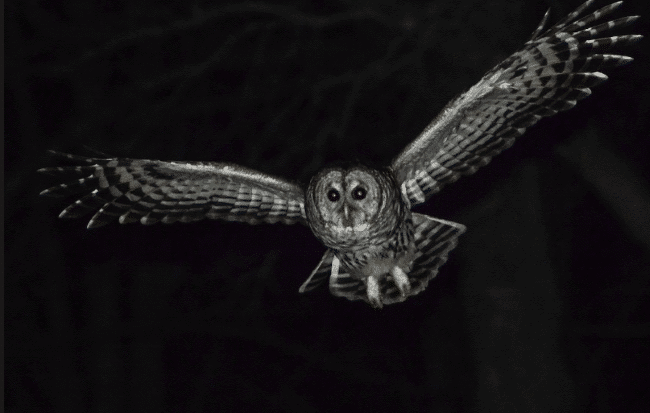
Barred Owl
Calvert, Maryland, United States
Photo © Oliver Griffin/Macaulay Library at the Cornell Lab
- Another key point is that some owls (like great horned owls) have significantly large eyes that help them locating the prey at night.
- The eyes tend to give the owl a binocular field of view.
- In the final analysis, the facial disc of the owl plays an equally important role in spotting the prey.
How Do Owls Eat their Prey?
- Depending on the size of animal, owls usually employ different strategies to eat their prey.
- In case of small prey items, owls tend to swallow them whole. For instance, snowy owls are capable of swallowing small birds and small mammals (like voles, lemmings) head-first.
- When the prey item is large enough, owls generally feed on it piecemeal. The large prey is normally pulled to pieces and dismembered while the head and feet are often discarded first.
- Some owls decapitate the prey and crush its bones before swallowing.
How Much Do Owls Eat?
- Depending on the particular season, size and availability of prey; the captive owls are generally known to eat 60 grams of mice every day. It means owls in captivity eat 10% of their own body mass.
- Some owls are observed to eat 25% to 30% of their own body weight.
- In the wild, owls are observed to consume an average of 110 grams of food.
- Owls have high metabolism rates which means they have to hunt and eat animals quite frequently.
- As compare to larger owls, smaller owls have higher metabolisms and they require more food each day.
- Elf owl is a small owl with very high metabolisms. For this reason, this owl eats almost 50% of its body weight daily.
- An adult barn owl can eat as much as 3 voles or 2 dead chicks every day.
- Captive great horned owls are known to drink 4% to 5% of their own body weight.
- In captivity, one of the snowy owls was reported to eat 200 to 400 grams of lemmings per day.
- In captivity, the great horned owls are known to eat 14 to 26 grams daily. But the daily food intake depends on the seasonal cycle and growth of the bird.
- The daily food consumption of captive barn owls varies from 46 grams during warmest times to 74 grams in the coldest periods. One captive female barn owl was found to eat 10% of her own body weight.
What Do Baby Owls Eat
- Owls have a wide range of diet. They can eat from small mammals to large birds as well as reptiles, amphibians and even insects. Thus, baby owls can eat just about any animal matter provided the prey is pulled apart and torn to pieces.

Great Horned Owl Babies
Indian River, Florida, United States
© Susan Grube/Macaulay Library at the Cornell Lab
- Great horned owls predominantly eat rabbits and hares. Therefore, in periods of high hares at Rochester, the baby great horned owls were documented to eat 328 to 411 grams per day.
- As far as feeding is concerned, the oldest owlet takes priority over its siblings. The parents will not feed the youngest sibling before the oldest baby owl.
What to Feed a Baby Owl
Actually, owls cannot chew the food rather they have to swallow it. However, unlike adult owls, baby owls cannot swallow the entire prey rather it must be dismembered and pulled apart. For that reason, baby owls must be fed by giving them small pieces of meat. It would be much better to feed a baby owl one or two chicks daily or small pieces of voles or mice.
What to Feed a Barn Owl? – Barn Owl Diet and Feeding
- When it comes to barn owl feeding, it must be clear that these birds of prey tend to swallow small prey items whole. It is not, however, recommended to give them small pieces of larger prey items.
- Insects may not be suitable for these owls rather a frog would be a much better choice.
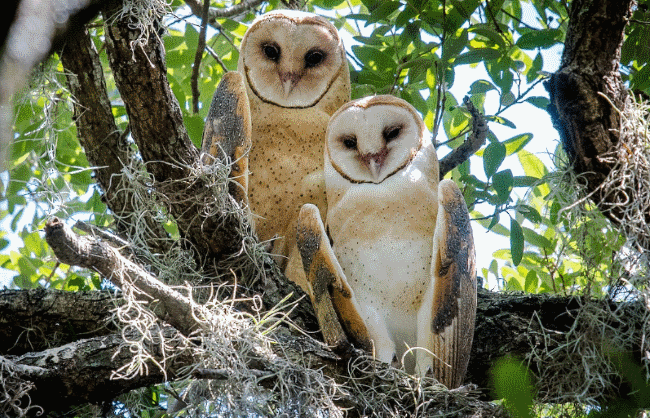
Barn Owls
Orange, Florida, United States
Photo © Melissa James/Macaulay Library at the Cornell Lab
- Do not feed these owls with wild rats because almost 70% of these rats have serious illness that humans can catch, known as leptospirosis. Feeding wild rats to barn owls is a better option if rodenticides are not used nearby.
- The dead cockerels are probably the most common food item for such owls because of the following reasons:
- High-protein and low-fat diet
- Economical and easy to use
- Feeding these owls with chicks is not suitable due to the presence of yolk and de-yolking is not good too, because it lowers phosphorous and calcium.
- The small to medium-sized domestic rats and mice provide best nutritional value for barn owls.
- The supplements are recommended only when dead mice are given to these birds for prolonged period of time. If small mammals are occasionally given along with regular diet of chicks, the supplements are not required. Overdose of supplements are harmful for barn owls and therefore, must be avoided.
What Do Owls Eat In The Wild And In Captivity
Owls are broadly divided into two families:
- Tytonidae (Barn-Owls)
- Strigidae (True Owls or Typical Owls)
What Do Barn Owls Eat
Barn owl (Tyto alba) is one of the most widely distributed and intensively studied bird of prey. Barn owl nests in cavities of trees, cliffs and caves. This owl has 28 subspecies but majority of these are poorly known.

Barn Owl
Metro Vancouver, British Columbia, Canada
Photo © Kenneth Trease/Macaulay Library at the Cornell Lab
- The major portion of barn owl diet consists of small mammals like voles, rats, mice, lemmings and shrews.
- Apart from rodents, these owls also feed on leporids (hares and jackrabbits), shrews and bats.
- Occasionally, barn owls also eat insects, reptiles, amphibians and birds. However, these food items form only smaller percentage of their food intake.
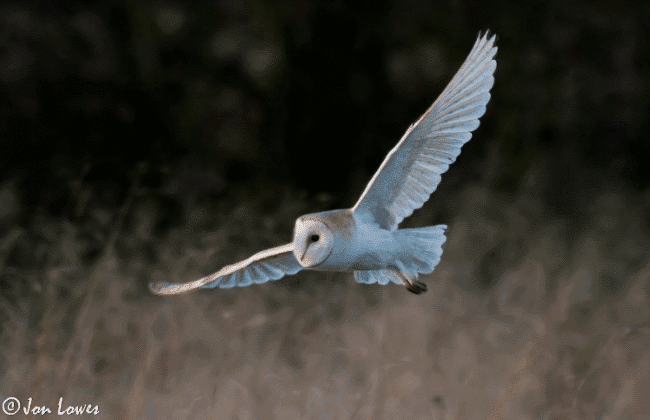
Barn Owl (Eurasian) Tyto alba [alba Group]Derbyshire, England, United Kingdom
Photo © Jon Lowes/Macaulay Library at the Cornell Lab
- Birds are not the favorite food of these owls and, therefore, rarely do they eat birds like starlings and meadowlarks.
- These birds do most of the hunting at night i.e. they are nocturnal species. Therefore, majority of the barn owl hunting takes place during the hours of darkness and continues until just before the first light.
- Hunting during the day is very rare but it occurs in open habitats.
- Barn owls soar off silently and detect prey with the help of their acute sense of hearing and excellent low-light vision.
- They tend to forage for prey in grasslands, open fields and marshes.
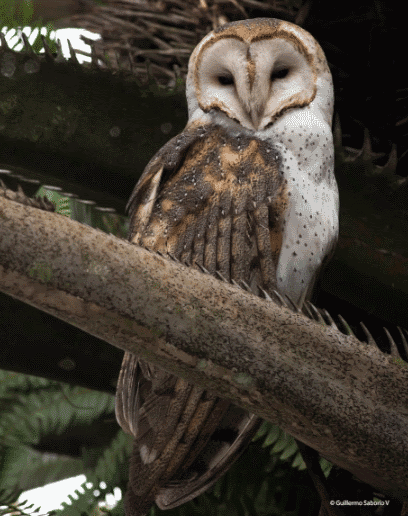
Barn Owl
Cartago, Costa Rica
Photo © Guillermo Saborío Vega/Macaulay Library at the Cornell Lab
- When the prey is small enough, the owl tends to swallow it whole but the large prey is eaten piecemeal.
- Barn owls largely prey on voles in North America. In the southeastern United States, they are often found eating cotton rats.
- The pocket mice form major component of barn owl diet throughout much of Southwest America.
What Animals Do Barn Owls Eat
- They tend to prey on a large number of small mammals. Thus, when it comes to barn owl eating habits, mice and rats seem to dominate its diet. These animals include:
- Bog lemmings
- Moles
- Pygmy mice
- Pocket mice
- Deer mice
- House mice
- Jumping mice
- Eurasian harvest mice
- Grasshopper mice
- Flying squirrels
- Kangaroo rats
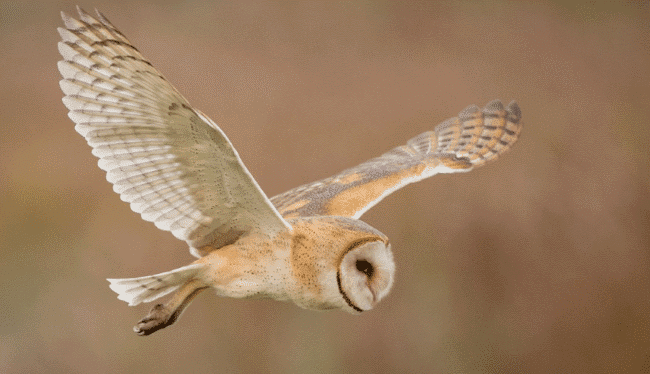
Barn Owl (American) Tyto alba [furcata Group]Cameron, Texas, United States
Photo © Ian Davies/Macaulay Library at the Cornell Lab
- The juvenile individuals of some of the larger mammals are also picked up as food. Such animals include:
- Muskrats
- Rice rats
- Brown or Norway rats
- House rats (also known as ship rats or black rats)
- Hares
- Rabbits
- Wood rats (packrats)
- Pocket gophers
- Apart from these animals, barn owls occasionally eat diurnal species like chipmunks and ground squirrels.
What Birds Do Barn Owls Eat

Barn Owl
Kings, New York, United States
Photo © Brian Kulvete/Macaulay Library at the Cornell Lab
- Although birds do not form main part of the owl’s diet, they are taken in small percentage. These owls usually eat following kinds of birds:
- Yellow-headed Blackbird
- Marsh wrens
- European Starling
- Meadowlarks
- Red-winged Blackbird
South American Barn Owl
- In Chile, South American barn owls tend to eat following animals:
- Oryzomys
- Akodon
- Rattus
- Abrocoma
- Marmosa
- Mus
- Phyllotis
- Octodon

Barn Owl (American) Tyto alba [furcata Group]Maranhão, Brazil
Photo © Alexander Lees/Macaulay Library at the Cornell Lab
- In Argentina, the following animals are taken by American barn owls:
- Reithrodon
- Akodon
- Calomys
- Mus
- Oligoryzomys
- Rattus
- Holochilus
- Ctenomys
- Eumops
- Eligmodonntia
- Scapteromys
- In Europe, some of the most common mammals eaten by such owls are voles, house mice, wood mice and shrews.

Barn Owl
Benavente, Santarém, Portugal
Photo © Rogério Rodrigues/Macaulay Library at the Cornell Lab
African Barn Owl
The diet of African barn owls mainly consists of the following small mammals:
- Mus
- Gerbillus
- Otomys
- Tatera
- Rattus
- Desmodillus
- Praomys

Barn Owl (African) Tyto alba affinis
North, Cameroon
Photo © Nigel Voaden/Macaulay Library at the Cornell Lab
- In Malaysia, the main food of barn owls consists of Rattus.
- In Australia, these birds of prey often eat Notomys, Mus and Rattus.
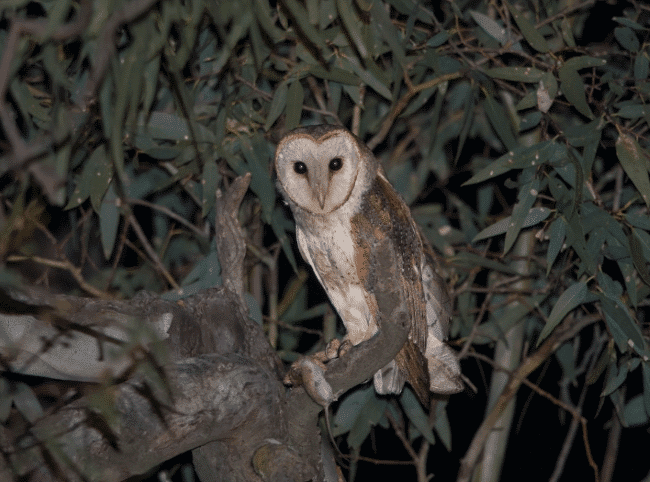
Barn Owl (Eastern) Tyto alba [delicatula Group]Conargo, New South Wales, Australia
Photo © Niall D Perrins/Macaulay Library at the Cornell Lab
What Do Barn Owls Eat in Captivity
- In captivity, it is found that barn owls seem to prefer eating Microtus.
How Many Animals Does a Barn Owl Eat Each Night
- According to one estimate, a female barn owl in captivity was found to consume an average of 60.5 grams each day. However, the consumption rates of this owl did not remain constant and varied with the changing patterns of seasons.
- During freezing times of year, consumption of up to 74 grams per day was documented. In the warmest time periods, the consumption rates were lower, as only 46.4 grams per day were taken. Even these estimates do not reflect the true pattern of daily food intake of these owls.
- On another occasion, American barn owls were found to consume an average of 150 grams per day in California.
- During summer, it was found that the daily food intake of American barn owls in Colorado was on average 110 grams per day.
What Do Baby Barn Owls Eat – Video
Source:
Marti, Carl D., Alan F. Poole and Louis R. Bevier (2005). Barn Owl (Tyto alba). The Birds of North America (A. Poole, Ed.) Ithaca: Cornell Laboratory of Ornithology; Retrieved from The Birds of North America:
https://birdsna.org/Species-Account/bna/species/brnowl
What Do True Owls Eat
What Do Snowy Owls Eat
Snowy owl (Bubo scandiacus) is one of the world’s largest owls. Also known as White or Arctic Owl, this owl breeds in the most northerly part of the world and also has the most wintering distribution. Snowy owl is one of the oldest species of birds recognized by prehistoric peoples. The owl occurs on Arctic tundra. These owls do foraging in grasslands, tundra, agricultural fields and coastlines.
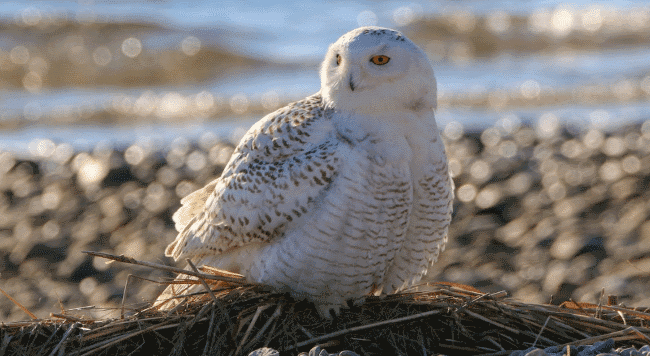
Snowy Owl
Plymouth, Massachusetts, United States
Photo © Jack McDonald/Macaulay Library at the Cornell Lab
- The snowy owl diet shows a great deal of variety because this owl is capable of hunting small as well as large mammals. In all, this owl tends to eat animals that are abundant in its habitat.
- According to one study, this bird was found to eat one mussel, 43 bird species, and 14 species of mammals.
- During breeding season, snowy owl eating habits reflect a large number of small mammals, particularly in the northern parts of America and Europe, but also Russia. Among these mammals, the most common are voles and lemmings.
- They are also found to eat carrion of animals like foxes, walruses, fish and seals.
- On one occasion, the Arctic owl was also found to eat fresh meat of Caribou, which was killed a little while back.
- Crustaceans and insects are also observed to take up as food.

Snowy Owl
Simcoe, Ontario, Canada
Photo © Robert Codd/Macaulay Library at the Cornell Lab
- When breeding season is off, snowy owls mainly hunt shorebirds and waterfowls in marshlands. Likewise, in grasslands, these owls are frequently found to hunt game birds or small mammals.
- In breeding season, however, small passerines and shorebirds often become prey to this owl, that captures them during flight.
- White owls tend to pick up sites with high densities of lemmings along with hares, birds and ground squirrels.
- As per Eskimo seal hunters, these owls tend to prey on sea ducks and sea birds in the Arctic.
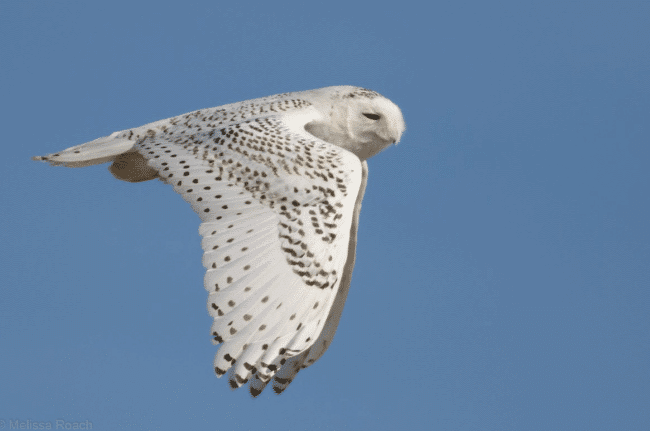
Snowy Owl
Ocean, New Jersey, United States
Photo © Melissa Roach/Macaulay Library at the Cornell Lab
- In addition to small mammals and birds, the snowy owl diet also includes some of the larger birds like:
- Great Blue Heron
- Peregrine Falcon
- Canada Goose
- Northern Harrier
- This owl is also observed to snatch prey from other owls and birds like jaegers, falcons, gulls and hawks.
- The diet of snowy owls in coastal British Columbia was reported to be made up of birds only. Here, the grebes and ducks (like Bufflehead and Horned Grebes) form 80% of the food intake of these owls.
- While observing one of these owls in captivity, it was found that this bird preferred mice over rats.
Watch this beautiful, short video on the life of snowy owl by The Cornell Lab of Ornithology, and enjoy!
- According to a study by Murie (1929) in Hooper Bay, the snowy owl food was dominated by waterfowls on swampy lands; and only rodents in uplands.
- The study of Dufresne (1922) in Nome reveals that snowy owl tends to consume ptarmigan more (instead of rodents) at the time of its hatching.
- It was observed by Robinson, Becker and Tullock on Fetlar I., Shetland that in the absence of lemmings, this owl mainly eats mice, rabbits and shorebirds.
- In Maine, the examination of 87 stomachs of these birds revealed the following:
- Mice and rats constitute 35% of the snowy owl diet
- Snowshoe hares constitute 20% of the owl’s diet
- Passerines constitute 10% of the owl’s diet
- Based on a study on 100 pellets in 1977-78, the diet of this owl in Alberta was dominated by deer mice and meadow voles.

Snowy Owl
Washington, New York, United States
Photo © Laura Labbe/Macaulay Library at the Cornell Lab
What Do Baby Snowy Owls Eat
- During captivity, a four-week-old baby snowy owl was observed to eat 3 to 9 lemmings in a day.
- In the wild, a baby snowy owl eats up to two lemmings a day.
Source:
Holt, D. W., M. D. Larson, N. Smith, D. L. Evans and D. F. Parmelee. 2015. Snowy Owl (Bubo scandiacus), version 2.0. In The Birds of North America (P. G. Rodewald, Editor). Cornell Lab of Ornithology, Ithaca, NY, USA.
https://doi.org/10.2173/bna.10
What Do Screech Owls Eat
- There are 21 recognized species of screech owls.
- They have well-developed claws and curved bill, enabling the bird to rip the prey to pieces.
- In order to eat, screech owls tend to take their prey to the nest.
- The hunting takes place in semi-open areas and such owls tend to prey on small mammals, reptiles and insects.
What Do Western Screech Owls Eat
Western screech owl (Megascops kennicottii) is a small owl that occurs in woodland habitats, especially deciduous forests. Western screech owls have magnificently camouflaged appearances. They are found in Central and northern part of United States. The size and color of these owls vary considerably. They appear to be quite tolerant of humans which is why they often nest on suburban parks.

Western Screech Owl
Stanislaus, California, United States
Photo © Jim Gain/Macaulay Library at the Cornell Lab
- These owls are nocturnal and opportunistic predators. They are capable of capturing insects during flight.
- This bird mainly eats small rodents. Apart from these, western screech owl also feeds on birds, reptiles, fish, amphibians, insects, slugs and snails.
- They tend to consume a lot more arthropods than eastern screech owl.
- Crayfish and large carpenter ants are probably the most dominant prey items of such owls in Seattle.
- In Arizona, the western screech owls tend to eat only mammals. Among these, the most commonly eaten are:
- Desert pocket mouse
- Southern grasshopper mouse
- White-throated wood rat
- Kangaroo rat
- Deer mice

Western Screech Owl
Ada, Idaho, United States
Photo © Kathy Lopez/Macaulay Library at the Cornell Lab
- Some of these owls were also found to eat caterpillar, crickets and even Northern Flicker in British Columbia.
- These owls seem to prefer house sparrows more than anything else, but only when these birds are abundant in their habitats.
- Apart from birds, some western screech owls were also observed to eat Pacific tree frogs and mountain whitefish. This implies that frogs and fish are pretty much among the favorite prey items of these owls.
- In Vancouver Island, they seem to eat Violet-green Swallow, tidepool sculpins and wintermoth caterpillars.
- In the southwest part of United States and North Mexico, the favorite food of these owls is Jerusalem crickets.
Source:
Cannings, Richard J., Tony Angell, Peter Pyle and Michael A. Patten (2017). Western Screech-Owl (Megascops kennicottii). The Birds of North America (A. Poole, Ed.) Ithaca: Cornell Laboratory of Ornithology; Retrieved from The Birds of North America: https://birdsna.org/Species-Account/bna/species/wesowl1/
What Do Eastern Screech Owls Eat
Eastern Screech Owl (Megascops asio) is a small owl that occurs on the eastern side of Rocky Mountains. These owls exist in two color-morphs i.e. gray and rufous. These birds tend to occupy both evergreen and deciduous forests as well as wooded suburban regions, wooded areas near meadows and fields.
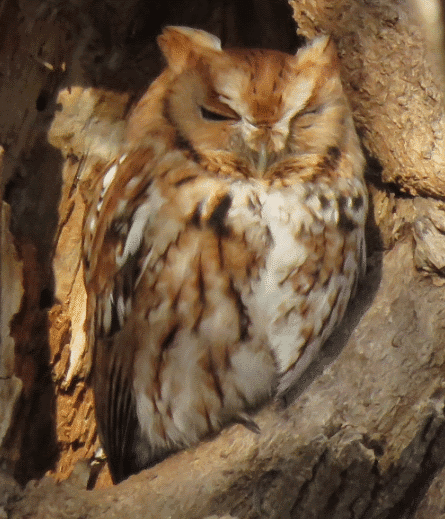
Eastern Screech Owl
Fairfax, Virginia, United States
Photo © Bryan Henson/Macaulay Library at the Cornell Lab
- Invertebrates are probably the most important prey items of eastern screech owls. They usually feed on earthworms, crayfish and insects.
- In vertebrates, the favorite food of these owls are rodents and songbirds.
- The eastern screech owl diet is made up of more than 138 different kinds of invertebrate species. The same is true for vertebrates. These owls have the most diverse diet than any other owl in North America.
- In winter, they seem to consume more vertebrates like rodents.
- During nesting period, eastern screech owls tend to eat different species of vertebrates and invertebrates as well as birds.
- In urban locales, these owls prefer eating more birds than mammals.

Eastern Screech-Owl
Arapahoe, Colorado, United States
Photo © Ryan Bushong/Macaulay Library at the Cornell Lab
- Eastern screech owls are known to eat the following:
- 18 mammalian species
- 83 bird species
- 16 reptile species
- 12 amphibian species
- 9 fish species
- Among mammals, about 67 percent squirrels and rodents are taken. Apart from these, other mammals include bats, moles, rabbits and shrews.
- In birds, these owls eat 85 percent songbirds.
- Among reptiles, the diet of these owls contains 62 percent of snakes.
- Eastern screech owl eats following kinds of birds:
- Warblers
- Mockingbirds
- Doves
- Swallows
- Creepers
- Thrushes
- Jays
- Thrashers
- House sparrows
- Flycatchers
- Finches
- Tits
- Starlings
- Wrens
- Vireos
- Waxwings
- Shorebirds (Scolopacidae, Charadriidae)
- Woodpeckers
- Small falcons
- Pigeons
- Gamebirds
- Owls (Strigidae)
- Cuckoos

Eastern Screech-Owl
Erie, Pennsylvania, United States
Photo © Robert Scribner/Macaulay Library at the Cornell Lab
- The diet of eastern screech owl includes nine genera of blind snakes (Leptophlopidae). These snakes include:
- Earth snakes
- Garter snakes
- Ground snakes
- Among lizards, this owl eats anoles, geckos, skinks and swifts.
- As for amphibians, this owl consumes larval forms of the following:
- Treefrogs
- Toads
- Mole salamanders
- Frogs
- Lungless salamanders
- Newts
- Eastern screech owl feeds on the following kinds of fish:
- Sunfish
- Silversides
- Catfish
- Shad
- Minnows
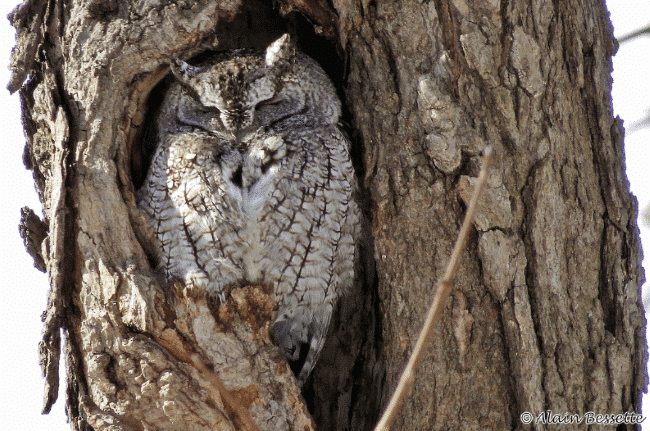
Eastern Screech-Owl
Montréal, Quebec, Canada
Photo © Alain Bessette/Macaulay Library at the Cornell Lab
- Among invertebrates, insects are probably the most favorite food of eastern screech owl. The following kinds of insects are taken:
- Grasshoppers
- Moths
- Cicadas
- Beetles
- Crickets
- Earthworms
- Crayfish
- Some of the other invertebrates are also eaten but only occasionally. These include:
- Pill bugs
- Snails
- Millipedes
- Centipedes
- Spiders
- Leeches
Source:
Ritchison, Gary, Frederick R. Gehlbach, Peter Pyle and Michael A. Patten. 2017. Eastern Screech-Owl (Megascops asio). The Birds of North America (A. Poole, Ed.) Ithaca: Cornell Laboratory of Ornithology; Retrieved from The Birds of North America: https://birdsna.org/Species-Account/bna/species/easowl1
What Do Great Horned Owls Eat
Great Horned Owl (Bubo virginianus) is a large and powerful owl with the most extensive range. This owl is an extremely adaptable bird, capable of surviving in almost any climate. It is also known as Hoot Owl or Tiger Owl and it is native to North and South America. It has big eyes that are perfectly adapted for night vision while its head can swivel more than 180 degrees.
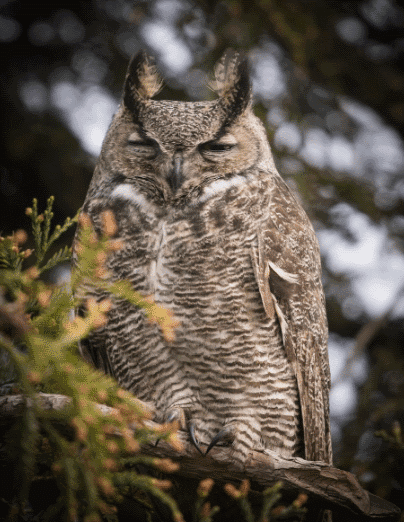
Great Horned Owl
Yolo, California, United States
Photo © Deb Ford/Macaulay Library at the Cornell Lab
- The great horned owl diet is one of the most diverse in North America.
- These owls are opportunistic feeders and they are capable of eating small and large, birds and mammals.
- The most commonly eaten prey items are:
- Waterfowls
- Voles
- Pocket gophers
- Mice
- Rabbits, hares and coots
- The wintering waterfowls are perhaps the most important prey for breeding great horned owls.
- Generally, they tend to consume a higher proportion of mammals i.e. 90 percent. The remaining 10 percent of their diet usually includes birds.
- Occasionally, these owls may also eat invertebrates including insects and some other reptiles and amphibians but these form only a small fraction of their diet.
- Great horned owl consumes a lot of large rodents.
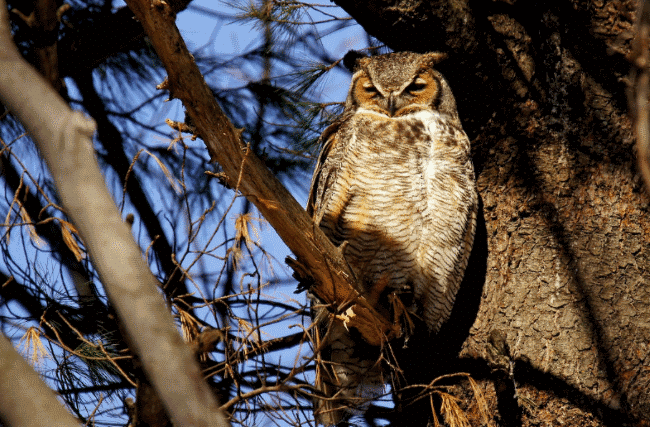
Great Horned Owl
Laval, Quebec, Canada
Photo © Doris Guimond et Claude Gagnon/Macaulay Library at the Cornell Lab
Mammals
- The following animals are usually taken by great horned owls if they are abundantly available:
- Wood rats
- Ground squirrels
- Norway rats
- Muskrats
- Pocket gophers
- Deer mice
- Kangaroo rats
- Voles
- Moles
- Some of the mammals occasionally eaten by these owls are:
- Woodchucks
- Black-tailed prairie dogs
- Squirrels
- Yellow-bellied marmots
- Porcupines
- Raccoons
- House cats
- Skunks
- Chipmunks
- Pocket mice
- Rice rats
- Shrews
- House mice
- Bats

Great Horned Owl
Weld, Colorado, United States
Photo © Steven Mlodinow/Macaulay Library at the Cornell Lab
Great Horned Owl Diet in Canada and the United States
- In Montana, this owl predominantly eats Microtus voles, accounting for more than 90 percent of its diet.
- In Jackson County, the most important winter food for this owl is cotton rat. It is observed that this rat makes up 66 percent of the owl’s diet.
- The key food item of this owl in Pennsylvania is opossums.
- The most important prey items of the great horned owl in Saskatchewan are Mallard and American Coots.
- These owls quite frequently eat rails and coots in North Dakota.

Great Horned Owl
Sarpy, Nebraska, United States
Photo © Karen Kader/Macaulay Library at the Cornell Lab
- According to research, almost 10 percent of the diet of great Horned owl in Washington was constituted of barn owls (research by Knight and Jackman 1984).
- This owl tends to steal nestlings of red-tailed hawks in central Alberta. In the boreal forest (in Alberta), during summer, about 80 percent of the diet of these owls consists of snowshoe hares, while hares constitute more than 90 percent of the owls’ winter diet.
- Likewise, the snowshoe hares were found to be an equally important prey item in the Taiga Biome of the Yukon Territory and Alaska.
- Great horned owls tend to eat voles, grouse, mice, ground squirrels and ducks when hares are hard to come by.
- The most important prey items of this owl in Wisconsin are Northern Bobwhite and Red-necked Pheasant.
- During the last quarter of every year in Colorado, the great horned owl diet mainly consists of jackrabbits and cotton tails. In May, the primary food of these owls is voles.

Great Horned Owl
Maricopa, Arizona, United States
Photo © Kevin Bergersen/Macaulay Library at the Cornell Lab
Birds
- Some of the birds in the great horned owl diet are:
- American coots
- Mallard
- European Starling
- Rock Pigeon
- Northern Saw-whet owl
- Eastern Screech-owl
- Short-eared owl
- Long-eared owl
- Barred owl
- Burrowing owl
- Osprey
- These owls often steal nestlings of the following birds:
- Common Raven
- Red-tailed hawk
- Broad-winged hawk
- Red-shouldered hawk
- American crow
Invertebrates
- Great horned owls consume following kinds of invertebrates:
- Crayfish
- Beetles
- Jerusalem crickets
- Giant water bugs
- Earthworms
- Scorpions
- Helminths
Source:
Artuso, Christian, C. Stuart Houston, Dwight G. Smith and Christoph Rohner (2013). Great Horned Owl(Bubo virginianus). The Birds of North America (A. Poole, Ed.) Ithaca: Cornell Laboratory of Ornithology; Retrieved from The Birds of North America: https://birdsna.org/Species-Account/bna/species/grhowl/
What Do Northern Hawk Owls Eat
Northern hawk-owl (Surnia ulula) is also known as American Hawk Owl or Canadian Owl. It is a non-migratory and one of the least-studied North American birds. This owl is distinctive because unlike most other owls that are either nocturnal or crepuscular, northern hawk owl tends to be active in daylight i.e. strictly diurnal species. This owl is the only extant species from its genus. Like its name, the behavior and appearance of this owl appears to be quite similar to hawks. These birds of prey inhabit coniferous forests and occupy habitats of clearings, meadows and swamp valleys. They are distributed unevenly across the boreal forest.

Northern Hawk Owl
St. Louis, Minnesota, United States
Photo © Michael O’Brien/Macaulay Library at the Cornell Lab
- The primary diet of northern hawk owls is generally small mammals. However, in winter, they tend to feed on birds.
- In Eurasia, northern hawk owls predominantly eat voles. In North America, the following species of voles (Microtus) are readily taken:
- Meadow vole
- Long-tailed vole
- Alaska vole
- Tundra vole
- Yellow-cheeked vole

Northern Hawk Owl
Ozaukee, Wisconsin, United States
Photo © Mike McDowell/Macaulay Library at the Cornell Lab
- In North America, the following mammals and birds are occasionally eaten by these owls:
Mammals
- Snowshoe hare
- Spruce grouse
- Short-tail weasel
- Mice and rats
- Rabbits
- Red squirrel
- Lemmings

Northern Hawk Owl
Athabasca, Alberta, Canada
Photo © Michael Butler/Macaulay Library at the Cornell Lab
Birds
- Pileated woodpecker
- Blackbirds
- masked shrew
- Starlings
- White-crowned sparrow
- House sparrow
- Tengmalm’s owl
- Partridge
- Doves
- Jays
- Robins
- Buntings
- Finches
- Grackles
- Blackbirds
- Spruce Grouse

Northern Hawk Owl
St. Louis, Minnesota, United States
Photo © Julie Zempel/Macaulay Library at the Cornell Lab
- From January to April, northern hawk owls fed almost entirely on bank voles in central Norway i.e. constituting 97 percent of their diet. However in time, the breeding season diet of such owls changes and they start eating Microtus voles, instead of bank voles.
- The winter diet of hawk owls is dominated by birds, in places like Finland. In Fennoscandia, the birds make up more than 90 percent of the diet of northern hawk owls.
- They are usually observed eating snow after they have had their meal.

Northern Hawk Owl
Finnmark, Norway
Photo © Christoph Moning/Macaulay Library at the Cornell Lab
Source:
Duncan, James R. and Patricia A. Duncan (2014). Northern Hawk Owl (Surnia ulula). The Birds of North America (A. Poole, Ed.) Ithaca: Cornell Laboratory of Ornithology; Retrieved from The Birds of North America: https://birdsna.org/Species-Account/bna/species/nohowl
What Do Elf Owls Eat
Elf owl (Micrathene whitneyi) is the smallest and lightest owl in the world. This owl inhabits desert vegetation and montane evergreen woodlands. Elf owls nest in abandoned cavities of woodpeckers in trees, fence posts and columnar cacti.
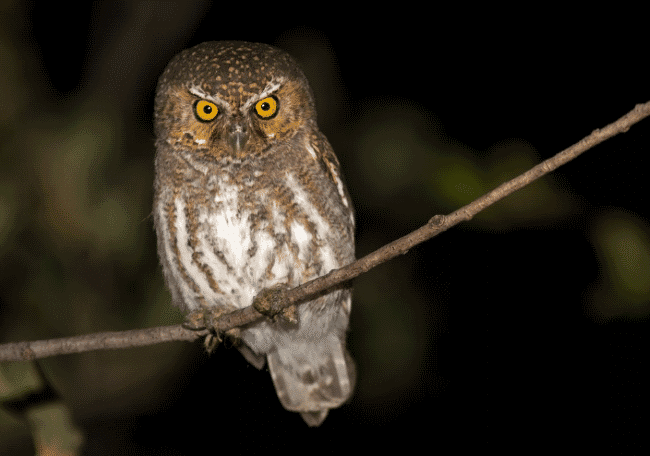
Elf Owl
Cochise, Arizona, United States
Photo © Kyle Blaney/Macaulay Library at the Cornell Lab
- During summer and spring, these owls tend to migrate to Arizona and Mexico, being the most abundant in deserts of these places.
- Elf owls are strictly nocturnal species and they mainly feed on insects.
- The primary diet of elf owls is arthropods. Elf owls are adept at capturing insects hidden under the vegetation or even during flight.
- Together with Flammulated owls, both these owls tend to eat insects at flowers.

Elf Owl
Santa Cruz, Arizona, United States
Photo © Jake Cvetas/Macaulay Library at the Cornell Lab
- For hunting, elf owl uses sit-and-wait strategy and then captures the prey with its feet. It may also run after the prey on ground like screech owls.
- Among arthropods, the insects from 22 families are taken by elf owls. In all, about 77 percent of the elf owl diet consists of insects.

Elf Owl
Santa Cruz, Arizona, United States
Photo © Max Leibowitz/Macaulay Library at the Cornell Lab
- Elf owls frequently eat following kinds of insects:
- Crickets
- Moths
- Beetles
- Scorpions
- Centipedes
- These owls feed on the following animals, but only rarely:
- Spiny lizards
- Young kangaroo rats
- Blind snakes
- Lizards
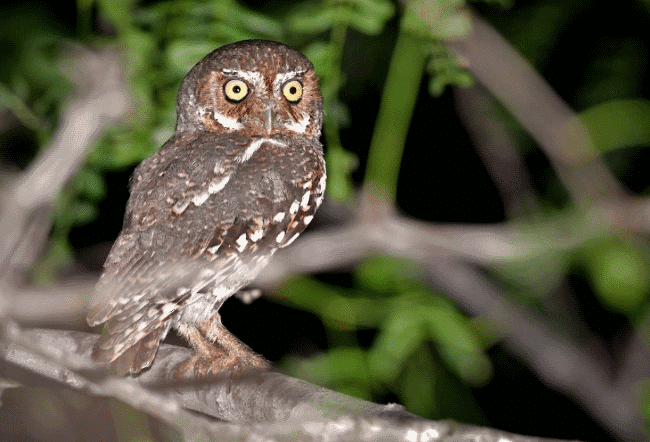
Elf Owl
Hidalgo, Texas, United States
Photo © Bryan Calk/Macaulay Library at the Cornell Lab
Source:
Henry, Susanna G. and Frederick R. Gehlbach. (1999). Elf Owl (Micrathene whitneyi). The Birds of North America (A. Poole, Ed.) Ithaca: Cornell Laboratory of Ornithology; Retrieved from The Birds of North America: https://birdsna.org/Species-Account/bna/species/elfowl
What Do Burrowing Owls Eat
Burrowing Owl (Athene cunicularia) is a small but charismatic owl. It inhabits grasslands and dry areas of western, northern and southern parts of America. Burrowing owl is a unique bird because it is a diurnal as well as nocturnal owl. This owl nests in underground burrows, and hence its name.

Burrowing Owl
Santa Bárbara, Jujuy, Argentina
Photo © Patrick MONNEY/Macaulay Library at the Cornell Lab
- They are generalist and opportunistic feeders.
- They are more active at dawn and dusk i.e. crepuscular owls.
- As far as feeding is concerned, insects and mammals seem to dominate the burrowing owl diet.
- They usually capture insects in daylight while they largely feed on vertebrates at dawn and dusk.
- They can go after almost anything whether it be birds, mammals, vertebrates or invertebrates. The general classification of prey items that these owls usually eat are:
- Bats
- Ground squirrels
- Earthworms
- Snakes
- Frogs
- Scorpions
- Salamanders
- Caterpillars
- Birds
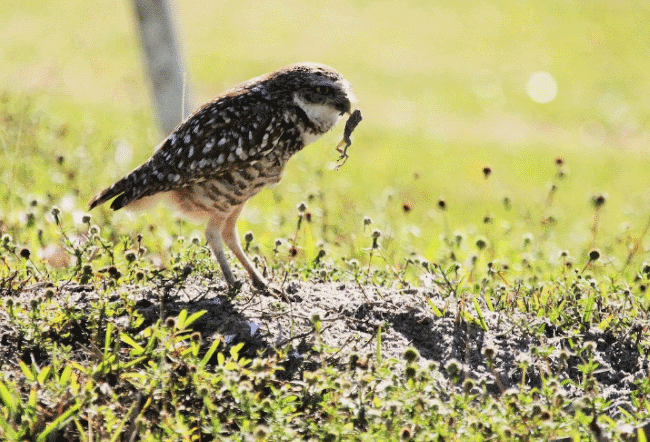
Burrowing Owl
Lee, Florida, United States
Photo © Anne Ruben/Macaulay Library at the Cornell Lab
What Do Burrowing Owls Mostly Eat
- In insects, burrowing owls frequently feed on the following:
- Beetles (like scarab and ground beetles)
- Crickets (like Jerusalem and True Crickets)
- Grasshoppers
- Moths
- In Washington and Oregon, the most frequently eaten insects are Scarabs and Tenebrionids.
- Among invertebrates, the most important prey of these owls in Washington is coulee cricket.
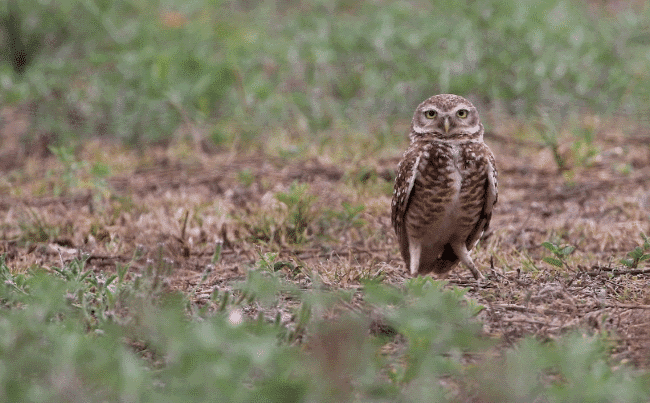
Burrowing Owl
Santa Bárbara, Jujuy, Argentina
Photo © Patrick MONNEY/Macaulay Library at the Cornell Lab
- In Oregon, the main prey of these owls are Jerusalem crickets.
- Among vertebrates, they are also found to eat Black-tailed jackrabbits and Mountain Cottontails.
- In Texas, crickets make up almost half of the burrowing owl diet. Among vertebrates, the most frequently eaten animals in this region are:
- Fulvous Harvest Mice
- Northern Pygmy Mice
- In Idaho, mammals like Deer Mice and Great Basin Pocket Mice often become prey to these owls.
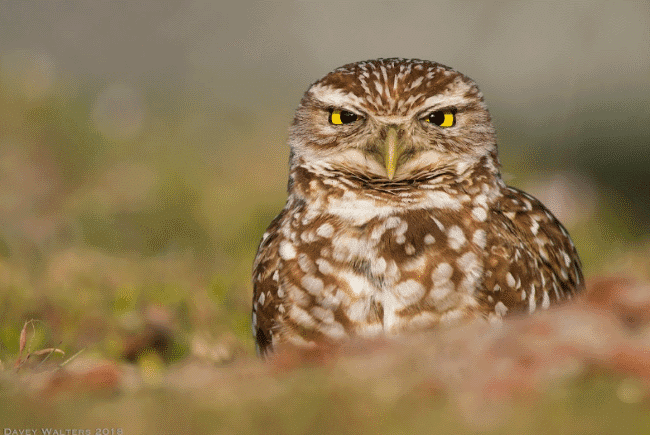
Burrowing Owl
Lee, Florida, United States
Photo © Davey Walters/Macaulay Library at the Cornell Lab
- Burrowing owls in the Imperial Valley of California feed more on Orthopterans (insects like grasshoppers, crickets etc.) i.e. accounting for 59 percent of their entire diet.
- Among vertebrates, in the North Dakota and Saskatchewan, the diet of burrowing owls is dominated by deer mice. Furthermore, these birds also frequently eat Meadow voles and Sagebrush voles.
- The most dominant prey of such owls in Colorado is probably Deer Mice.
- In places like Washington, Wyoming, Texas, Colorado, Brazil and Chile, the dominant food of these birds consists of invertebrates. Thus, these owls eat following kinds of invertebrates in such regions:
- Moths
- Grasshoppers
- Scorpions
- Earwigs
- Giant water bugs
- Beetles
- Worms
- sun scorpions
- Termites
- Caterpillars
- Crustaceans
- Wolf Spiders
- Furthermore, the burrowing owl diet also includes following kinds of vertebrates:
- Ground squirrels
- Frogs and toads
- Lizards (like tropical house gecko)
- Snakes
- Small weasels
- Turtles
- Mice (like delicate vesper mouse)
- Bats
- Shrews
- Young lagomorphs
- Waterbirds
- Songbirds
- Blackbirds
- Doves (eared and young mourning doves)
- Voles
- Young ducks
- Young burrowing owls
- Strangely enough, but these owls have this distinctive characteristic that they feed on seeds and fruits too. They tend to prefer eating fruits of desert Christmas cactus, prickly pear and cholla cacti.

Burrowing Owl
Orange, California, United States
Photo © Trish Gussler/Macaulay Library at the Cornell Lab
Sources:
Poulin, Ray G., L. Danielle Todd, E. A. Haug, B. A. Millsap and Mark S. Martell. 2011. Burrowing Owl (Athene cunicularia). The Birds of North America (A. Poole, Ed.) Ithaca: Cornell Laboratory of Ornithology; Retrieved from The Birds of North America: https://birdsna.org/Species-Account/bna/species/burowl
Brattstrom, Bayard H. and Thomas R. Howell. “The Birds of the Revilla Gigedo Islands, Mexico” (1956).
Junior, Jose Carlos Motta. “TROPHIC RELATIONSHIPS BETWEEN STRIGIFORMES FIVE SYMPATRIC IN THE CENTRAL REGION OF SÃO PAULO, BRAZIL”(2006). REVISTA BRASILEIRA DE ORNITOLOGIA – Brazilian Journal of Ornithology.
What Do Spotted Owls Eat
Spotted Owl (Strix occidentalis) is one of the best-studied owls in the world. It is a nocturnal owl and nests in tree or rock crevices. Spotted owls occupy coniferous and hardwood forests.
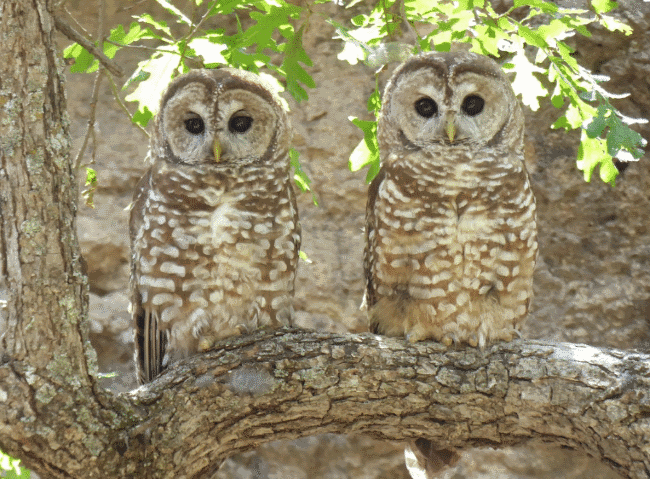
Spotted Owl
Socorro, New Mexico, United States
Photo © J Joseph/Macaulay Library at the Cornell Lab
- These owls use sit-and-wait technique to hunt animals.
- Spotted owls quite frequently hunt wood rats and northern flying squirrels.
- Occasionally, they may also eat bats, birds (like jays, woodpeckers), reptiles and amphibians.
- The primary diet of spotted owls consists of mammals, small to medium sized.
- There are three species of spotted owls:
- Northern Spotted Owl (Strix Occidentals caurina)
- California Spotted Owl (S. o. occidentalis)
- Mexican Spotted Owl (S. o. lucida)
What Do Northern Spotted Owls Eat
Northern Spotted Owl (Strix occidentalis caurina) is a medium-sized owl with dark brown color. It is among very few owls that have dark colored eyes.

Spotted Owl (Northern) Strix occidentalis caurina
Benton, Oregon, United States
Photo © Hendrik Herlyn/Macaulay Library at the Cornell Lab
- The major portion of northern spotted owl diet is composed of mammals. At the same time, these birds of prey may also feed on insects, birds and amphibians.
- The dominant food of northern spotted owls is northern flying squirrels (Glaucomys sabrinus) in their northern range.
- In the southern portion of the owl’s range, the northern spotted owl mainly eats Ducky-footed woodrats (Neotoma fuscipes).
- The diet of Northern spotted owl also includes following kinds of mammals:
- Mice
- Red-backed voles
- Brush rabbits
- Red tree voles
- Bushy-tailed woodrats
- Snowshoe hares
- Pocket gophers
What Do California Spotted Owls Eat
- The most important mammals in the diet of California spotted owls are flying squirrels and dusky-footed woodrats.
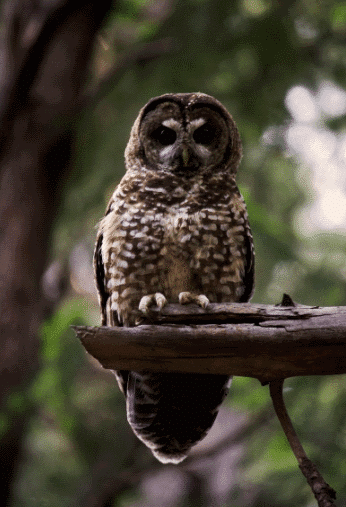
Spotted Owl (California) Strix occidentalis occidentalis
Placer, California, United States
Photo © Jade Arneson/Macaulay Library at the Cornell Lab
- In Sierra Nevada, flying squirrel is the dominant prey item at higher elevations while dusky-footed woodrat is an important food species in lower elevations.
- Some of the other mammals that fall prey to the California spotted owls are:
- Mice
- Pocket gophers
- Douglas squirrel
- Western Gray squirrel
- California Ground squirrel
- Eutamias spp. (genus of chipmunks from the family of squirrels)
What Do Mexican Spotted Owls Eat
The most dominant food in the diet of Mexican spotted owls is Neotoma species like woodrat. Apart from these, these owls also feed on:
- Bats (Chiroptera)
- Peromyscus rabbits (Sylvilagus spp.)
- Voles (Microtus spp.)

Spotted Owl (Mexican) Strix occidentalis lucida
Cochise, Arizona, United States
Photo © Liam Wolff/Macaulay Library at the Cornell Lab
Source:
Gutiérrez, R. J., A. B. Franklin and W. S. Lahaye. 1995. Spotted Owl (Strix occidentalis). The Birds of North America (A. Poole, Ed.) Ithaca: Cornell Laboratory of Ornithology; Retrieved from The Birds of North America: https://birdsna.org/Species-Account/bna/species/spoowl
What Do Barred Owls Eat
Barred Owl (Strix varia) is also known as Hoot Owl and it is widely distributed much of eastern part of United States and southern Canada. Unlike other owls in eastern America that have yellow eyes, barred owl is the only owl in its range to have brown eyes. These owls tend to occupy mostly thick deep forests, wooded swamps and deciduous trees.

Barred Owl Strix varia
Lee, Florida, United States
Photo © Emily Tornga/Macaulay Library at the Cornell Lab
- Some of the favorite mammalian prey of barred owls are meadow voles, mice and shrews. In addition to these, these owls also eat:
- Rats
- Moles
- Opossums
- Squirrels
- Weasels
- Rabbits
- Mink
- Bats
- Occasionally, they may also feed on birds including:
- Doves
- Jays
- Woodpeckers
- Quails
- Pigeons
- Grouse
- Icterids
- Domestic chickens and ducks
- Smaller owls
- Barred owls are sometimes found to wade into water for hunting:
- Crayfish
- Turtles
- Frogs
- Fish
- Some of the other prey items of these owls include:
- Earthworms
- Beetles
- Grasshoppers
- Crickets
- Salamanders
- Snakes
- Scorpions
- Lizards
- Slugs
- Barred owls are opportunistic predators and they tend to eat a wide range of different animals like mammals, reptiles, birds, amphibians and invertebrates.
- In order to hunt, these birds of prey often use sit-and-wait strategy and soar off in pursuit of prey from a high perch.
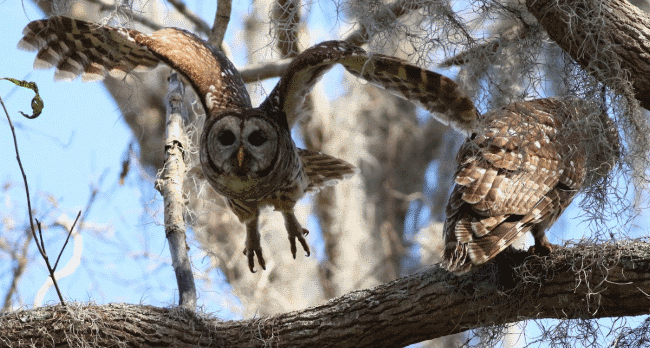
Barred Owl Strix varia
Pinellas, Florida, United States
Photo © John & Ivy Gibbons/Macaulay Library at the Cornell Lab
- This owl is usually observed capturing a vole on the ground and on another occasion, it is found chasing a red squirrel.
- They can locate small mammals scurrying under the snow during winter.
- Barred owls are also reported to chase the amphibians on ground while running after them.
- In case of larger prey items, they usually consume head first but the smaller prey is swallowed whole.
- It was once reported that during breeding season in New York and New Jersey, more than half of the diet of barred owls consisted mainly of mammals (55 percent). The remaining portion was mainly made up of invertebrates (23 percent) and birds (16 percent) while fish and amphibians accounted for only a small fraction of the owl’s diet.
- In Nova Scotia, mammals constituted more than 60 percent of the barred owl’s diet while the rest of its food was mainly made up of invertebrates (17 percent) and amphibians (12 percent).

Barred Owl (Northern) Strix varia [varia Group]Nanaimo, British Columbia, Canada
Photo © Braden Judson/Macaulay Library at the Cornell Lab
- In 1987, Snyder and Wiley reported that mammals constituted about 76 percent of the owl diet in North America; invertebrates accounted for 15.8 percent and birds just less than 6 percent.
- Mammals account for the largest portion of the winter diet of these owls. Among these, the most important mammals are rodents from the families sciurid and cricetid.
- The summer diet of barred owls is often made up of invertebrates, amphibians and reptiles.

Barred Owl (Northern) Strix varia [varia Group]Nanaimo, British Columbia, Canada
Photo © Braden Judson/Macaulay Library at the Cornell Lab
Mazur, Kurt M. and Paul C. James. 2000. Barred Owl (Strix varia). The Birds of North America (A. Poole, Ed.) Ithaca: Cornell Laboratory of Ornithology; Retrieved from The Birds of North America: https://birdsna.org/Species-Account/bna/species/brdowl
Livezey, Kent B. and James C. Bednarz. “BARRED OWL HABITAT AND PREY: A REVIEW AND SYNTHESIS OF THE LITERATURE”. Journal of Raptor Research. The Raptor Research Foundation, Inc. 30 April 2007. www.bioone.org Year accessed: 2018
Hamer, Thomas E., David L. Hays, Clyde M. Senger, Eric D. Forsman. “Diets of Northern Barred Owls and Northern Spotted Owls in an Area of Sympatry”. Searchable Ornithological Research Archive. Journal of Raptor Research. 2001. sora.unm.edu. Year accessed: 2018
Livezey, Kent B., Mark F. Elderkin, Peter A. Cott, Jared Hobbs and John P. Hudson. “Barred Owls Eating Worms and Slugs: The Advantage in Not Being Picky Eaters”. JSTOR. Society for Northwestern Vertebrate Biology. 2008. jstor.org. Year accessed: 2018
What Do Great Gray Owls Eat
Great Gray Owl (Strix nebulosa) is the largest owl in North America. It inhabits throughout Northern Hemisphere occupying deep forests of coniferous trees. This owl seems to have a preference for forest edges and montane meadows.

Great Gray Owl Strix nebulosa
Thompson-Nicola, British Columbia, Canada
Photo © Brad Vissia/Macaulay Library at the Cornell Lab
- They tend to hunt from low elevated perch like tree limb or fence post. These owls usually hunt in dark but they are also crepuscular hunters.
- The primary diet of great gray owls is rodents and such other small mammals.

Great Gray Owl Strix nebulosa
St. Louis, Minnesota, United States
Photo © Greg Hottman/Macaulay Library at the Cornell Lab
- They tend to hover above the snow and plunge downward by breaking off the hard snow crust, while clenching the prey with their powerful feet.
- Great gray owls may be nocturnal during winter but they are largely crepuscular species.
- Pocket gophers are more commonly eaten in Sierra Nevada, California.
- To the north of Canada, these owls mainly feed on lemmings.
- In North America and Canada, the great gray owl diet predominantly consists of voles (Microtus spp.).
- In Northwest Wyoming, Idaho and Yosemite National Park, the dominant prey of great gray owls is pocket gophers.

Great Gray Owl Strix nebulosa
St. Louis, Minnesota, United States
Photo © Robin Oxley/Macaulay Library at the Cornell Lab
- Some of the other mammals and birds that occasionally fall prey to the great gray owl are:
- Red-backed vole
- Red squirrel
- Flying squirrel
- Deer mouse
- Jumping mouse
- Grasshopper mouse
- Northern Short-tailed shrew
- Microsorex hoyi
- Sorex spp
- Heather vole
- Short-tail weasel
- Least weasel
- Snowshoe hare
- Northern bog lemming
- Star-nosed mole
- American Robin
- Broad-winged hawk
- Sharp-skinned hawk
- Great jay
- Spruce Grouse
- Anas spp.
- Wood frog

Great Gray Owl Strix nebulosa
Lake, Minnesota, United States
Photo © Ben Barkley/Macaulay Library at the Cornell Lab
- It is reported that, at times, these owls face intense competition from other owls (like great horned owl, boreal owl and long-eared owl) in search of prey because of the same habitat. In Oregon, the diet of great gray owls and long-eared owls is very much the same.
Source:
Bull, Evelyn L. and James R. Duncan. 1993. Great Gray Owl (Strix nebulosa). The Birds of North America (A. Poole, Ed.) Ithaca: Cornell Laboratory of Ornithology; Retrieved from The Birds of North America: https://birdsna.org/Species-Account/bna/species/grgowl
What Do Long-eared Owls Eat
Long-eared Owl (Asio otus) is a medium-sized owl. It is found in evergreen conifer edges and agricultural areas of Eurasia and North America. These owls use abandoned stick nests of other birds.
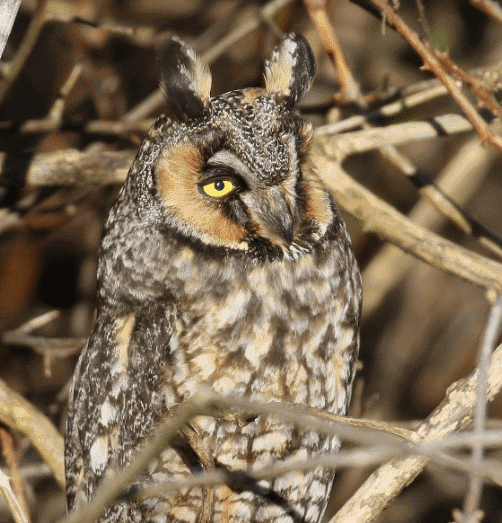
Long-eared Owl Asio otus
Metro Vancouver, British Columbia, Canada
Photo © Kenneth Trease/Macaulay Library at the Cornell Lab
- Long eared owls are largely nocturnal but they may also hunt in daylight like they often do in Finland.
- For hunting, these owls do not normally hover over the prey and they are not known to capture prey during flight. These birds of prey tend to bite off their prey’s skull.
- The diet of long eared owls consists of a lot of small-sized mammals primarily because they are opportunist hunters.
- In North America, the most important prey of these owls are voles like:
- Montane voles
- Prairie voles
- Meadow voles

Long-eared Owl Asio otus
King, Washington, United States
Photo © Joe Sweeney/Macaulay Library at the Cornell Lab
- In Great Plains states, the dominant food of such owls are white-footed mouse and deer mouse.
- The diet of these owls in arid regions mainly consists of kangaroo rats and pocket mice.
- In Oregon, the most important prey was found to be pocket gophers.

Long-eared Owl Asio otus
Metro Vancouver, British Columbia, Canada
Photo © Joshua Glant/Macaulay Library at the Cornell Lab
- Some of the common prey items in North America are:
- Blarina (genus of large shrews like American short-tailed shrew)
- Cryptotis (genus of small shrews like Nelson’s Small Eared shrew)
- Sorex (genus of common shrews containing 142 known species)
- Sylvilagus (like cottontail rabbits)
- Lepus (hares and jackrabbits)
- Juvenile rats
- Grasshopper mice
- Passerine birds
- Long eared owls occasionally eat following kinds of animals and birds:
- Western whiptail lizard
- Short-horned lizard
- Sagebrush lizard
- Glossy snake
- DeKay’s snake
- Evening bat
- Little brown bat
- Hoary bat
- Pallid bat
- Starnose mole
- Townsend’s ground squirrel
- Long-tailed weasel
- Least chipmunk
- Red squirrel
- Ruffed grouse
- In Iraq, it was reported that half of the owl’s diet consisted of house sparrows.
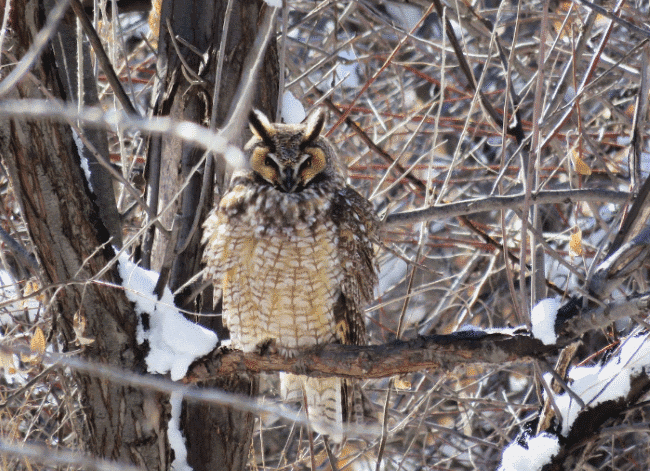
Long-eared Owl Asio otus
Arapahoe, Colorado, United States
Photo © Karen Drozda/Macaulay Library at the Cornell Lab
Source:
Marks, Jeffrey S., Dave L. Evans and Denver W. Holt. 1994. Long-eared Owl (Asio otus). The Birds of North America (A. Poole, Ed.) Ithaca: Cornell Laboratory of Ornithology; Retrieved from The Birds of North America: https://birdsna.org/Species-Account/bna/species/loeowl
What Do Short-eared Owls Eat
Short-eared Owl (Asio flammeus) is a medium-sized owl that is found in grassland regions and open country habitats. These owls are one of the most widely distributed birds in the world, except Australia and Antarctica. These birds of prey nest in tundra, prairie and meadow areas.

Short-eared Owl Asio flammeus
Grayson, Texas, United States
Photo © Jack Chiles/Macaulay Library at the Cornell Lab
- The preferred food of short-eared owls is rodents, mainly meadow voles. In addition to these, they may also feed on other mammals including:
- Ground Squirrels
- Moles
- Shrews
- Muskrats
- Deer mice
- Bats
- Rats
- They are nocturnal as well as diurnal owls.
- These owls are well known for their bouncy flight, which is quite unique. This owl uses a number of flight adaptations along with acute hearing sense, as foraging techniques.

Short-eared Owl Asio flammeus
Al Jahrah, Kuwait
Photo © Sajan Raju/Macaulay Library at the Cornell Lab
- In order to kill its prey, the owl may hover over it before dropping down to grab the animal.
- Short-eared owls do not quite often hunt from perches. In case of smaller prey, these owls tend to swallow it whole while the larger mammals are eaten piecemeal, with their heads clipped off first.
- The short-eared owl diet is mostly dominated by small mammals.
- During winter, these birds of prey tend to become crepuscular owls i.e. hunt at dawn and dusk.

Short-eared Owl Asio flammeus
Fauquier, Virginia, United States
Photo © Elton Morel/Macaulay Library at the Cornell Lab
- In North America, the most important prey of these owls is Microtus (genus of voles). In addition to these, some of the other mammals in the diet of such owls include:
- Rabbits (Lepus, Sylvilagus)
- Moles
- Shrews (Blarina, Sorex)
- Pocket gophers
- Kangaroo rats
- Pocket mice
- Lemmings
- Harvest mice
- Voles
- Deer mice
- House mice
- Rats
- Jumping mice
- Ground Squirrels
- Occasionally though, the short-eared owl diet may also include following kinds of mammals:
- Short-tailed weasel
- Big brown bat
- Norway rat
- Color morph of meadow vole
- Muskrat
- Although these birds of prey do not frequently eat birds in great numbers, it has been reported that they tend to prefer eating more birds in coastal regions.
- In the coastal regions of California, it is reported that birds make up around 51-88% of the diet of short-eared owls. (Research by Page and Whitacre 1975)
- These owls are found to kill following birds in Massachusetts:
- Laughing gulls
- Common terns
- Shorebirds
- Passerines

Short-eared Owl (Hawaiian) Asio flammeus sandwichensis
Hawaii, Hawaii, United States
Photo © Terry Bohling/Macaulay Library at the Cornell Lab
- According to a study by Kumlien over 600 owl’s feathers in Wisconsin, the nest of single owl represented 32 bird species and no mammals.
- Seabirds are the most dominant prey of these owls in the Galapagos Island.
- In the Hawaiian Island, Kauai, these owls are frequently found to hunt adult and fledglings of Hawaiian Thrush.
- Some of the other avian prey items of these owls include:
- Rails
- Storm-petrels
- Plovers
- Sandpipers and allies
- Species from the order Passeriformes

Short-eared Owl Asio flammeus
Somerset, Maryland, United States
Photo © Mark Johnson/Macaulay Library at the Cornell Lab
- Some of the occasionally eaten birds are:
- White tern
- Leach’s Storm-Petrel
- Wilson’s Storm-Petrel
- Clapper Rail
- Starlings
- Tyrant Flycatchers
- Seabirds
- Larks
- Icterids
- Pipits
- Short-eared owls rarely prey on following kinds of insects:
- Grasshoppers
- Caterpillars
- Roaches
- Beetles
- Katydids
Sources:
Wiggins, D. A., Denver W. Holt and S. M. Leasure. 2006. Short-eared Owl (Asio flammeus). The Birds of North America (A. Poole, Ed.) Ithaca: Cornell Laboratory of Ornithology; Retrieved from The Birds of North America: https://birdsna.org/Species-Account/bna/species/sheowl
Lewis, Deane. “Short-eared Owl“. The Owl Pages.
What Do Boreal Owls Eat
Boreal Owl (Aegolius funereus) inhabits subalpine and boreal forests and it is the most abundant bird in Scandinavia. In Eurasia, this bird of prey is known as Tengmalm’s Owl. It occurs in deep forest of conifers across Eurasia and North America.

Boreal Owl Aegolius funereus
Bayern, Germany
Photo © Christoph Moning/Macaulay Library at the Cornell Lab
- Boreal owls use sit-and-wait technique for hunting and foraging usually begins after the sunset.
- As the owl locates its prey, it may wait for about ten minutes before soaring off from around 10-meter perch.
- Boreal owls may eat smaller animals with head usually consumed first while the larger ones are eaten piecemeal.

Boreal Owl Aegolius funereus
Québec, Quebec, Canada
Photo © Steeve R. Baker/Macaulay Library at the Cornell Lab
- The primary diet of boreal owls in North America includes:
- Heather voles
- Red-backed voles
- Microtus spp.
- Jumping mice
- Deer mice
- Sorex spp.
- Northern pocket gophers
- Northern flying squirrels
- Chipmunks

Boreal Owl Aegolius funereus
St. Louis, Minnesota, United States
Photo © Tom Reed/Macaulay Library at the Cornell Lab
Birds and Insects
Following birds and insects are eaten by boreal owls:
- Thrushes (Catharus spp.)
- Dark-eyed Junco
- Warblers
- American Robin
- Red Crossbill
- Mountain Chickadee
- Woodpeckers
- Common Redpoll
- Kinglets
- Crickets
Mammals
- The boreal owls occasionally eat following mammals:
- Pica
- Juvenile snowshoe hare
- Weasel (Mustela spp.)
- Bushy-tailed woodrat

Boreal Owl Aegolius funereus
St. Louis, Minnesota, United States
Photo © Alan Van Norman/Macaulay Library at the Cornell Lab
- The composition of boreal owl diet in Colorado revealed that red-backed voles constituted 54% of the owl’s prey species while 25% of the owl’s food consisted of Microtus. The study was conducted on 72 prey species of these owls.
- During early spring in Finland, boreal owls were found to consume higher proportion of mammals like bank voles and Microtus spp. In winter, however, the owls tend to feed more on birds and shrews.
- Boreal owls are not found to drink in the wild while the captive owls are certainly known to drink.
Source:
Hayward, G. D. and P. H. Hayward. 1993. Boreal Owl (Aegolius funereus). The Birds of North America (A. Poole, Ed.) Ithaca: Cornell Laboratory of Ornithology; Retrieved from The Birds of North America: https://birdsna.org/Species-Account/bna/species/borowl
What Do Northern Saw-whet Owls Eat
Northern Saw-whet Owl (Aegolius acadicus) is one of the smallest and most common owls across North America and southern Canada. These owls inhabit coniferous forests of white cedar swamps and woodland habitats. In size, they are similar to American robin.

Northern Saw-whet Owl Aegolius acadicus
La Tuque, Quebec, Canada
Photo © Yves Dugré/Macaulay Library at the Cornell Lab
- The preferred food of northern saw-whet owls are white-footed mice and deer mice.
- Northern saw-whet owls are opportunistic predators. They tend to hunt on forest edges and clearings.
- They are nocturnal owls and therefore, hunting mainly takes place in complete darkness.
- The owl roosts on low elevated branches or shrubs (1.5 to 3 meters high). In winter, however, diurnal hunting may occur but only rarely. By means of its acute hearing sense, this owl detects its prey and captures the animal with its feet.

Northern Saw-whet Owl Aegolius acadicus
Lake, Minnesota, United States
Photo © David McQuade/Macaulay Library at the Cornell Lab
- In North Carolina, shrews (Cryptotis, Blarina, Sorex) make up more than fifty percent of the northern saw-whet owl diet. In addition to these, two other important prey species that these birds of prey frequently eat are white-footed mice and deer mice.
- The diet of saw-whet owl in Idaho mainly consists of the following mammals:
- Harvest mice
- House mice
- Montane voles
- During breeding season in Manitoba, it was reported that out of a total of 14 prey items (in 17 pellets) of this owl, saw-whet owl consumed 8 red-backed voles.
- During early spring and winter, the most dominant prey of these owls is voles.
Mammals
- Some of the other small mammals taken by this owl are:
- Pocket mice
- Harvest mice
- Jumping mice
- Bog lemmings
- Shrew-moles
- Shrews
- Heather voles
- Red tree voles
- Silver-haired bat
- The juveniles of the following large mammals are occasionally taken as food:
- Squirrels (especially southern flying squirrel)
- Chipmunks
- Pocket gophers (especially northern pocket gopher)
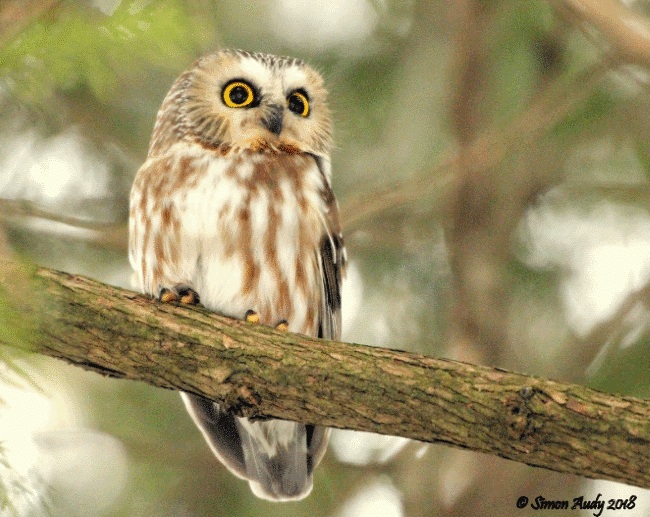
Northern Saw-whet Owl Aegolius acadicus
Les Collines-de-l’Outaouais, Quebec, Canada
Photo © Simon Audy/Macaulay Library at the Cornell Lab
Birds
- Birds do not form greater proportion of the northern saw-whet owl diet. They are normally hunted during migration.
- During winter in Connecticut, Golden-crowned Kinglet and Tufted Titmouse constituted only 1.1% of the prey items of this owl.
- According to the prey remains from the owl’s nest box in Maryland, this owl appeared to eat woodland jumping mouse and swamp sparrow.
- In Haida Gwaii (or Queen Charlotte Islands, Canada), the saw-whet owl was reported to take juvenile individuals of the following birds:
- Chestnut-backed Chickadee
- Hermit Thrush
- Ancient Murrelets
- Golden-crowned Kinglet
Some of the other birds taken by these owls are:
- Ruby-crowned Kinglet
- American Robin
- Winter Wren
- Yellow-rumped Warbler
- Northern Pygmy-Owl
- Least Flycatcher
- Northern Cardinal
- Pine Siskin
- Cedar Waxwing
- Vesper Sparrow

Northern Saw-whet Owl Aegolius acadicus
Maricopa, Arizona, United States
Photo © Chris McCreedy/Macaulay Library at the Cornell Lab
Invertebrates
- Among invertebrates, these owls are reported to eat quite a lot of grasshoppers and beetles.
- During winter in the Queen Charlotte Islands, almost half of the owl’s diet consists of insects.
- They were reported to eat spiders and amphipods, among other insects. Besides, western toad is also found to be taken by these owls.
- Some of the other invertebrates within the diet of this owl includes:
- Lepidoptera
- Homoptera
- Orthoptera
- In comparison with boreal owls, saw-whet owls tend to eat more shrews.
- According to research, these birds of prey tend to feed on those mammals that are generally available in abundance within their territories. For that reason, in British Columbia (as well as in Colorado), the diet of these owls was almost entirely made up of deer mice (84%).
- It is not certain whether these owls select territories with abundance of prey or more likely, they choose prey which is present in highest proportion in those territories.
- The surplus prey items that are not consumed by the owls, are usually stored in the nest boxes on branches.
- The saw-whet owls seem to select their prey based on its size, how vulnerable it is and by the choice of habitat.

Northern Saw-whet Owl Aegolius acadicus
Algoma, Ontario, Canada
Photo © Barry Lyons/Macaulay Library at the Cornell Lab
Source:
Rasmussen, Justin Lee, Spencer G. Sealy and Richard J. Cannings. 2008. Northern Saw-whet Owl (Aegolius acadicus). The Birds of North America (A. Poole, Ed.) Ithaca: Cornell Laboratory of Ornithology; Retrieved from The Birds of North America: https://birdsna.org/Species-Account/bna/species/nswowl
What Do Northern Pygmy-Owls Eat
Northern Pygmy-Owl (Glaucidium gnoma) is one of the smallest North American owls. This owl is known to be a fierce hunter. It is widely distributed across United States, Canada and Mexico occupying wooded canyons, including coniferous forests and pine-oak woodland.

Northern Pygmy-Owl Glaucidium gnoma
Plumas, California, United States
Photo © Julie Newman/Macaulay Library at the Cornell Lab
- They are diurnal owls. Therefore, most of the hunts usually take place in daylight.
- These owls tend to use perch-and-pounce technique for foraging. Unlike most other owls, pygmy owl hunts mostly with the help of its vision rather than hearing.
- Small birds and insects form major portion of the northern pygmy owl diet.
- In Montana, passerines are mostly picked up as food by these owls.
- On one occasion, this owl was found to pick up a nestling of a Downy Woodpecker from its cavity.
- According to Bendire, one of these owls was reported to strike a wood mouse at its back.
- These owls were also observed to pull out three winter wrens and one Brown Creeper from the nests.
- Northern pygmy owls are known to eat a wide variety of prey items including mammals, reptiles, birds and insects.

Northern Pygmy-Owl Glaucidium gnoma
Calgary, Alberta, Canada
Photo © Katherine Corkery/Macaulay Library at the Cornell Lab
Insects
- Among insects, the following kinds of prey items are usually eaten:
- Crickets
- Butterflies
- Moths
- Cicadas
- Dragonflies
- Beetles
- Grasshoppers
Reptiles
- In reptiles, these owls tend to eat:
- Fence lizard
- Whiptail lizard
- Alligator lizard
- Skinks
Birds
- In birds, they are found to eat the following:
- Woodpeckers
- Swallows
- Creepers
- Wrens
- Waxwings
- Warblers
- Hummingbirds
- Flycatchers
- Jays
- Chickadees
- Nuthatches
- Thrushes
- Finches
- Vireos
- Blackbirds
- Starlings
- Sparrows

Northern Pygmy-Owl Glaucidium gnoma
Edson, Alberta, Canada
Photo © Denise Chambers/Macaulay Library at the Cornell Lab
Mammals
- The northern pygmy owl diet includes following mammals:
- Mice
- Moles
- Tree squirrels
- Shrews
- Pocket gophers
- Jumping mice
- Chipmunks
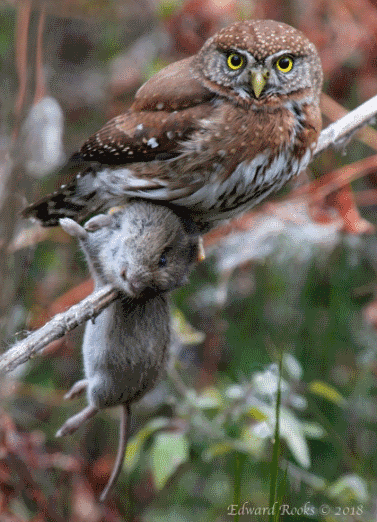
Northern Pygmy-Owl Glaucidium gnoma
Santa Clara, California, United States
Photo © David Zittin/Macaulay Library at the Cornell Lab
- These owls appear to have a special interest in some of the larger prey items like:
- Juvenile domestic chicken
- Gambel’s Quail
- California Quail
- Northern Bobwhite
- Northern Flickers
- American Robin
- Red Squirrel
Source:
Holt, Denver W. and Julie L. Petersen. 2000. Northern Pygmy-Owl (Glaucidium gnoma). The Birds of North America (A. Poole, Ed.) Ithaca: Cornell Laboratory of Ornithology; Retrieved from The Birds of North America: https://birdsna.org/Species-Account/bna/species/nopowl
What Do Ferruginous Pygmy-Owls Eat
Ferruginous Pygmy-Owl (Glaucidium brasilianum) is a small owl that occupies variety of habitats including desert riverine woods.
- These owls are known to feed on large insects like:
- Beetles
- Crickets
- Caterpillars
- Scorpions

Ferruginous Pygmy-Owl Glaucidium brasilianum
Roraima, Brazil
Photo © Thompson Ian/Macaulay Library at the Cornell Lab
- In addition to these, such owls are found to eat small mammals especially rodents, as well as small birds and lizards.
- In Texas, the primary diet of ferruginous pygmy owls consists of insects like grasshoppers. Besides, in Arizona, they may also eat small mammals, birds, reptiles and amphibians.
- They are usually found to capture their prey from low elevated perch on branches. In Texas, the hunt takes place in mesquite brush areas.
- These birds are primarily diurnal owls.
- One of the most common foraging techniques of these owls is perch-to-prey.
- They are not found to capture prey during flight.
- In Texas, such owls were observed to pull out Golden-fronted Woodpecker and nestling of Brown-crested Flycatcher from the nest cavities.

Ferruginous Pygmy-Owl Glaucidium brasilianum
Kenedy, Texas, United States
Photo © Susan Wrisley/Macaulay Library at the Cornell Lab
- Ferruginous pygmy owls were found to swallow lizards, especially Great Plains skink and four-lined skink whole.
- Some of the larger lizards are eaten piecemeal. These lizards include Texas spotted whiptail and six-lined race runner.
- In Veracruz (Mexico), these owls tend to feed more frequently on crickets, grasshoppers and scorpions.
- In Texas and Arizona, it is reported that some of the largest prey items eaten by ferruginous pygmy owls were hispid cotton rat and Gambel’s Quail, while the smallest ones were lightning bugs and sphinx moth.
- According to South Americans, they also fed on Jacu-hen (Penelope sp.).
- The most unusual prey eaten by these owls was reported to be narrow-mouth toad.
Sources:
Proudfoot, Glenn A. and R. Roy Johnson. 2000. Ferruginous Pygmy-Owl (Glaucidium brasilianum). The Birds of North America (A. Poole, Ed.) Ithaca: Cornell Laboratory of Ornithology; Retrieved from The Birds of North America: https://birdsna.org/Species-Account/bna/species/fepowl
Kaufman, Kenn. “Ferruginous Pygmy-Owl“. Audobon – Guide to North American Birds.
What Do Whiskered Screech-Owls Eat
Whiskered Screech-Owl (Megascops trichopsis) is a small owl that is native to North and Central America. This owl occupies canyons and thick broad-leaved oaks.
- The primary food of these owls consists of large insects. These include:
- Katydids
- Caterpillars
- Crickets
- Beetles
- Moths
- Scorpions
- Centipedes

Whiskered Screech-Owl Megascops trichopsis
Cochise, Arizona, United States
Photo © Frank Mantlik/Macaulay Library at the Cornell Lab
- Apart from these, the diet of whiskered owls also includes:
- Lizards
- Mice
- Bats
- Shrews
- Birds
- Snakes
- These owls appear to be opportunistic predators.
- The diet of whiskered screech owls is composed almost entirely of arthropods.
- These owls forage for their prey in mainly deciduous vegetation and evergreen oak leaves.
- The foraging activity usually occurs from a height of up to four meters.
- Whiskered screech owls tend to hunt using sit-and-wait technique.
- These owls have the ability to either make a sudden dive on the prey, hover over it or go after the prey directly.
- By means of their feet, they can capture the prey on tree trunks or leaf litter.
- In pursuit of insects, these owls tend to do hopping and walking on the ground.
- In Mexico and Arizona, the diet of such owls is found to consist of 26 arthropod taxa.
- Studies in Arizona suggest that the highest proportion of food was made up of insects including beetles, moths and caterpillars.
- In El Salvador, such owls usually eat mice and shrews, among others.
- Some of the smaller vertebrate prey items eaten by whiskered screech owls include:
- Texas blind snake
- Yarrow’s spiny lizard
- Brush mouse
- Cave bat

Whiskered Screech-Owl Megascops trichopsis
Santa Cruz, Arizona, United States
Photo © Aaron Marshall/Macaulay Library at the Cornell Lab
Sources:
Gehlbach, Frederick R., Nancy Y. Gehlbach, Peter Pyle and Michael A. Patten. 2017. Whiskered Screech-Owl (Megascops trichopsis). The Birds of North America (A. Poole, Ed.) Ithaca: Cornell Laboratory of Ornithology; Retrieved from The Birds of North America: https://birdsna.org/Species-Account/bna/species/whsowl1
Kaufman, Kenn. “Whiskered Screech-Owl“. Audobon – Guide to North American Birds
What Do Flammulated Owls Eat
Flammulated Owl (Psiloscops flammeolus) is a tiny migratory owl that derives its name from its facial markings that look like flame. This owl occurs from western part of United States to central Mexico.

Flammulated Owl Psiloscops flammeolus
Salt Lake, Utah, United States
Photo © Tim Avery/Macaulay Library at the Cornell Lab
- In fall, this small owl tends to leave America and Canada. This owl nests in open forest and occupies habitats of mountainous pine trees.
- Flammulated owls are nocturnal species. Therefore, they tend to feed primarily on nocturnal arthropods.
- Some of the favorite prey items of these owls are:
- Grasshoppers
- Crickets
- Beetles
- Owlet and geometrid moths
- During summer in North America, the diet of flammulated owls is dominated by:
- Moths
- Crickets
- Beetles
- Grasshoppers
- True bugs
- These owls are also observed to feed on centipedes, spiders and scorpions. It is not known to eat vertebrates.
- In Oregon, there had been reports of finding remains of Dark-eyed Junco and red-backed vole in the pellets in flammulated owls’ nests.
- From 1992 to 2001, the presence of songbirds, Peromyscus sp. and various bats have also been reported from the nest boxes of these owls in Utah.
- These owls do not seem to capture small vertebrate prey.

Flammulated Owl Psiloscops flammeolus
Wasatch, Utah, United States
Photo © Tim Avery/Macaulay Library at the Cornell Lab
Sources:
Linkhart, Brian D. and D. Archibald McCallum. 2013. Flammulated Owl (Psiloscops flammeolus). The Birds of North America (A. Poole, Ed.) Ithaca: Cornell Laboratory of Ornithology; Retrieved from The Birds of North America: https://birdsna.org/Species-Account/bna/species/flaowl
Kaufman, Kenn. “Flammulated Owl“. Audobon – Guide to North American Birds
What Do Madagascar Red Owls Eat
Madagascar red owl (Tyto soumagnei) is a medium-sized and strictly nocturnal owl. The hunting occurs at night in open areas and forest edges. These owls are also known to hunt in human-made open habitats near forest (like rice-paddies).
- The diet of these owls primarily consists of small native mammals.

Madagascar Red Owl Tyto soumagnei
Mahajanga, Madagascar
Photo © Alan Van Norman/Macaulay Library at the Cornell Lab
- In Ankarana, North Madagascar, almost half of the prey items of these owls is made up of Tsingy tufted-tailed rat.
- These owls are also known to eat geckos, frogs and insects.
Source:
BirdLife International. 2016. Tyto soumagnei. The IUCN Red List of Threatened Species 2016: e.T22688493A93198777. http://dx.doi.org/10.2305/IUCN.UK.2016-3.RLTS.T22688493A93198777.en
What Do Australian Masked Owls Eat
- Australian masked owl (Tyto novaehollandiae) belongs to the family of Barn Owl. This owl is native to Australia and southern parts of New Guinea.

Australian Masked-Owl Tyto novaehollandiae
East Gippsland, Victoria, Australia
Photo © Tim Bawden/Macaulay Library at the Cornell Lab
- These owls are nocturnal species.
- Most of the foraging activity occurs on ground.
- The primary diet of these owls consists of rabbit-sized mammals.
- Some of the prey items of these owls include:
- Small dasyurids
- Rodents
- Rabbits
- Reptiles
- Possums
- Bandicoots
- Insects
- Birds
- Lizards
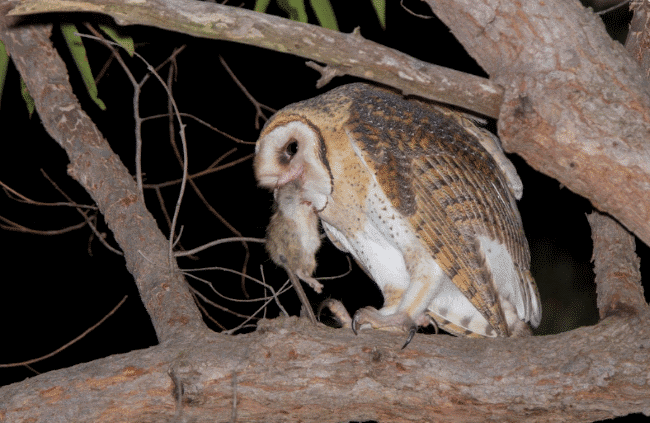
Australian Masked-Owl Tyto novaehollandiae
Campbelltown, New South Wales, Australia
© Timothy Paasila/Macaulay Library at the Cornell Lab
Source:
Lewis, Deane. “Australian Masked Owl“. The Owl Pages
What Do Greater Sooty Owls Eat
Greater Sooty Owl (Tyto tenebricosa) is a medium-to-large sized territorial owl. This owl is native to New Guinea’s Montane Rainforests and Southeast Australia. This bird is also witnessed on Flinders Islands of Tasmania.

Sooty Owl (Greater) Tyto tenebricosa tenebricosa/arfaki
Sunshine Coast, Queensland, Australia
Photo © Scott Baker/Macaulay Library at the Cornell Lab
- The large arboreal make up the highest proportion of prey items of these owls.
- The diet of greater sooty owls mainly consists of the following animals:
- Greater glider
- Sugar gliders
- Rodents
- Ringtail possums
- Antechinus
- Bandicoots
- Occasionally, these owls can consume insects, birds and bats.
Source:
Lewis, Deane. “Greater Sooty Owl“. The Owl Pages
Bilney, Rohan J., Raylene Cooke and John White. “Change in the diet of sooty owls (Tyto tenebricosa) since European Settlement: from terrestrial to arboreal prey and increased overlap with powerful owls”. Wildlife Research. Date of publishing: March 7, 2006. Year Accessed: 2018
What Do Ashy-faced Owls Eat
Ashy-faced Barn Owl (Tyto glaucops) is a medium-sized owl that is found in the Dominican Republic and Haiti. This owl is also known as Hispaniolan Barn Owl simply because it is endemic to the Caribbean island of Hispaniola. This owl occupies open woodland, scrublands, agricultural fields and forest habitats. Ashy-faced owl is slightly smaller than Caribbean Barn Owl and the only bird in its genus to have grey face.

Ashy-faced Owl Tyto glaucops
Pedernales, Dominican Republic
Photo © Andrew Spencer/Macaulay Library at the Cornell Lab
- These owls are nocturnal species.
- The diet of ashy-faced owls is dominated by small mammals, mainly rodents. These owls are expert hunters of rats and mice (like Barn Owl) but they may also eat lizards and tree frogs.
- In addition to small mammals, they also feed on insects, reptiles, frogs and birds.
- According to one report, these owls are believed to eat following prey items:
- 13 bat species
- 23 reptile species
- 9 amphibian species
- 80 species of birds (including Egrets and American Kestrels)
Sources:
“Ashy-faced Owl“. The Peregrine Fund – Conserving birds of prey worldwide
Lewis, Deane. “Ashy-faced Owl“. The Owl Pages
What Do Eastern Grass Owls Eat
Also known as Australian grass owl, Eastern Grass Owl (Tyto longimembris) is a medium-sized owl with long slender legs. These owls occur in Australia, New Guinea and southeastern parts of Asia.

Australasian Grass-Owl Tyto longimembris
Townsville, Queensland, Australia
Photo © Ivor Preston/Macaulay Library at the Cornell Lab
- In size it is similar to barn owl.
- These owls are nocturnal species.
- The prey is detected from 4 to 5 meters above ground thanks to the owl’s acute sense of hearing.
- After the prey is captured, the owl tends to stay on ground.
- The diet of these owls is dominated by mammals like small rodents. Grass owls are essentially quite skilled in catching rodents.
- According to research, eastern grass owls are often found to eat cane rat and long-haired rat.
- Apart from rodents, they are also reported to feed on birds and insects.
Sources:
Lewis, Deane. “Eastern Grass Owl“. The Owl Pages
“Eastern Grass Owl“. Birds in Backyards
What Do African Grass Owls Eat
Also called as Common Grass Owl, African Grass Owl (Tyto capensis) is a medium-sized owl with a heart-shaped facial disc. This owl occurs in open savanna, dry and moist grasslands. It is distributed across central and southern Africa (southern Congo to north of Angola), and in east Africa (Ethiopian Highlands to the Cape).
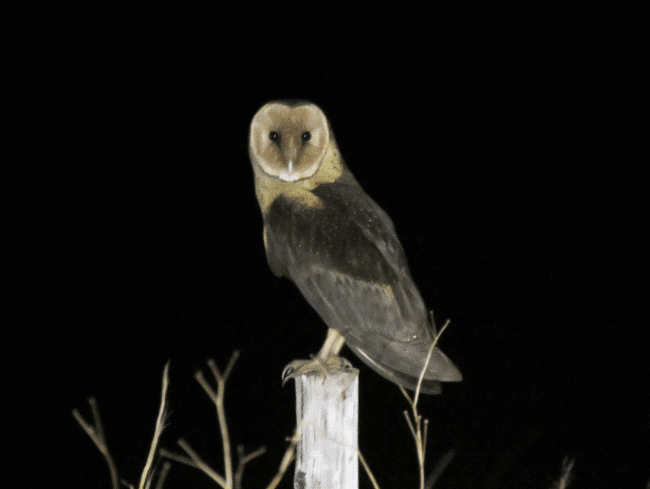
African Grass-Owl Tyto capensis
Mpumalanga, South Africa
Photo © Brad Arthur/Macaulay Library at the Cornell Lab
- African grass owls are similar in appearance to barn owls.
- They don’t have a nest. These owls roost on a pad of trampled grass.
- These owls predominantly eat small mammals especially rodents.
- They are mostly nocturnal but if the prey is available, the owl may hunt at dawn and dusk.
- Even though frogs are usually available, they are rarely caught which means African grass owls do not appear to have a liking for them.
- The owl employs sit-and-wait strategy for hunting.
- In southern Africa, the following mammals are reported to be eaten by African grass owls:
- Duthie’s golden mole
- African marsh rat
- South African hedgehog
- Cape mole-rat
- African vlei rats (Otomys) – the most favorite prey of African grass owls
- Multimammate mice from the genus of rodents, Mastomys spp. (African soft-furred rats)
- Bats
- Hares
- Elephant shrews
Some of the non-mammalian prey items of African grass owls include:
- Gallinago nigripennis
- Termites
- Frogs
- Large insects
- African Snipe
- Black Crake
- Other birds (small passerines to doves)
Sources:
“Tyto capensis (African Grass-Owl)“. Biodiversity Explorer – The web of life in Southern Africa
“African Grass-Owl“. The Owl Pages
Steyn, Peter. “A Delight of Owls: African Owls observed”
What Do Sri Lanka Bay Owls Eat
Sri Lanka Bay Owl (Phodilus assimilis) is a strange-looking small owl with heart-shaped facial disc. It is endemic to southwestern part of India (Western Ghats in the state of Kerala) and Sri Lanka. This owl occupies moist montane forests and tropical grasslands.

Sri Lanka Bay-Owl Phodilus assimilis
Ernakulam, Kerala, India
Photo © jaya samkutty/Macaulay Library at the Cornell Lab
- The hunting and feeding habits of these owls are poorly known.
- Research on four pellets suggested that this owl consumed small rodents because of the presence of bones and fur of these mammals.
Sources:
Mikkola, Heimo. “Owls of the World: A Photographic Guide”.
Lewis, Deane. “Sri Lanka Bay Owl“. The Owl Pages
What Do Oriental Bay Owls Eat
Also called Asian Bay Owl, Oriental Bay Owl (Phodilus badius) is a strange-looking small owl with reddish-brown color and heart-shaped facial disc. It occurs in Southeast Asia.

Oriental Bay-Owl Phodilus badius
Phetchaburi, Thailand
Photo © ian dugdale/Macaulay Library at the Cornell Lab
- These owls are completely nocturnal species.
- Since oriental bay owls tend to hunt in complete darkness, they tend to use their extremely keen hearing senses.
- They eat a wide variety of prey items including:
- Small birds
- Frogs
- Reptiles
- Small rodents like mice and rats
- Large insects (grasshoppers and beetles)
- Bats
- Lizards
Source:
“Oriental Bay Owl”. Arkive
What Do Reddish Scops Owls Eat
Also called Rufous Scops Owl, Reddish Scops Owl (Otus rufescens) is a very small nocturnal owl with rounded wings and visible ear-tufts. This owl is native to southeast Asia and occupies lowland evergreen and submontane forests. Like screech owls, these owls belong to the genus Otus, which contains 45 species.

Reddish Scops-Owl Otus rufescens
Pahang, Malaysia
© Dave Bakewell/Macaulay Library at the Cornell Lab
- The hunting and feeding habits of these owls are largely unknown.
- The owl is often found to hunt in lower parts of the forest and is, therefore, forest-dependent owl.
- Studies suggest that the primary food of the reddish scops owl is insects.
- Among insects, the preferred diet of these owls appeared to be crickets and grasshoppers.
- They are also known to eat crab parts.
Sources:
Lewis, Deane. “Reddish Scops Owl“. The Owl Pages
Mikkola, Heimo. “Owls of the World: A Photographic Guide”.
What Do Andaman Scops Owls Eat
Andaman Scops Owl (Otus balli) is a tiny and agile bird of prey with prominent ear-tufts. This owl exists in reddish-brown and grayish-brown appearance. This bird is endemic to the Andaman Islands and also occurs in Great Nicobar Island. Andaman scops owl roosts on tree cavities in the cultivated areas near human settlements.

Andaman Scops-Owl Otus balli
South Andaman, Andaman and Nicobar Islands, India
Photo © Shakti vel/Macaulay Library at the Cornell Lab
- It is largely nocturnal species.
- For hunting, these owls tend to move sideways and in a parrot-like fashion to capture the prey on ground.
- The primary diet of Andaman scops owls consists of caterpillars.
- They are also known to capture beetles, insect larvae and other insects.
Sources:
BirdLife International. 2017. Otus balli. The IUCN Red List of Threatened Species 2017: e.T22688573A118257284. http://dx.doi.org/10.2305/IUCN.UK.2017-3.RLTS.T22688573A118257284.en
Holt, D.W., Berkley, R., Deppe, C., Enríquez Rocha, P., Petersen, J.L., Rangel Salazar, J.L., Segars, K.P., Wood, K.L. & Sharpe, C.J. (2018). Andaman Scops-owl (Otus balli). In: del Hoyo, J., Elliott, A., Sargatal, J., Christie, D.A. & de Juana, E. (eds.). Handbook of the Birds of the World Alive. Lynx Edicions, Barcelona. (retrieved from https://www.hbw.com/node/54941 on 28 February 2018)
Raheem, Mahmood Syed. “Andaman Scops Owl“. Birds of India
What Do Mountain Scops Owls Eat
Also called spotted scops owl, Mountain Scops Owl (Otus spilocephalus) is a small owl with blunt wings and orange-rufous-brown appearance. This owl tends to do foraging in lower canopy of thick forests. It is distributed across eastern and southwestern parts of Asia.

Mountain Scops-Owl Otus spilocephalus
New Taipei City, Taiwan
Photo © Lee-Lien Wang/Macaulay Library at the Cornell Lab
- It is a very small owl with short ear-tufts.
- Studies on few stomachs of mountain scops owl suggest that this owl mainly feeds on large insects including:
- Beetles
- Moths
- Cicadas
- Grasshoppers
- Mantises
Apart from these, they are also known to eat:
- Birds
- Small rodents
- Lizards
Sources:
Mikkola, Heimo. “Owls of the World: A Photographic Guide”
“Mountain scops-owl“. Birds of India
Lewis, Deane. “Mountain Scops owl“. The Owl Pages
What Do Javan Scops Owls Eat
Javan Scops Owl (Otus angelinae) is a very rare small owl with rufous-brown appearance and relatively long ear-tufts. This silent forest-dwelling bird is endemic to Indonesia and it is widely distributed across western and eastern parts of Java island. This owl is known to occur in seven mountains of Indonesia.

Javan Scops Owl Photo © Indonesia Kehati
- These owls mainly prefer larger insects like:
- Praying mantises
- Grasshoppers
- Beetles
- Occasionally, they may also hunt snakes and small lizards.
- They are not known to capture insects during flight. The prey is usually captured from a tree branch or ground by means of claws.
Sources:
BirdLife International. 2016. Otus angelinae. The IUCN Red List of Threatened Species 2016: e.T22688591A93201974. http://dx.doi.org/10.2305/IUCN.UK.2016-3.RLTS.T22688591A93201974.en
Mikkola, Heimo. “Owls of the World: A Photographic Guide”
“Javan Scops Owl“. Planet of Birds
What Animals Do Owls Eat
Do Owls Eat Mice
- Barn owls eat mice like pygmy mice, pocket and eurasian harvest mice.
- Western screech owls feed on desert pocket mice.
- Burrowing owls feed on great basin pocket mice.
- Great gray owls and boreal owls eat jumping mice.
- Long-eared owls eat white-footed, pocket and deer mice.
- Some of the owls that feed on grasshopper mice are long-eared owls, barn owls, western screech owls and great gray owls.
- Few common owls that usually feed on deer mice are barn owls, western screech owls, burrowing owls, boreal owls, great horned owls, northern saw-whet owls and great gray owls.
- Northern saw-whet owls eat house mice, harvest mice, jumping mice and pocket mice.
- Great horned owls are also known to eat pocket mice and house mice.
- Northern pygmy owls feed on jumping mice.
- Whiskered screech owls eat brush mice.
- Ashy-faced owls are efficient hunters of mice.
What Do Owls Eat besides Mice
Apart from mice, owls eat many different kinds of food items including snakes, bats, frogs, rats, turtles, squirrels, rabbits, fish, voles, shrews, robins and pigeons. Also, the diet of most owls contains a wide variety of large insects and crustaceans including caterpillars, grasshoppers, butterflies, crabs, crickets, moths, beetles and more. Few owls are also reported to kill even cats, dogs and chickens.
Do Owls Eat Snakes
- Owls eat different kinds of reptilian prey like snakes and lizards.
- Screech owls eat different kinds of snakes like garter, ground, blind and earth snakes.
- Elf owls and whiskered screech owls feed on blind snakes.
- Burrowing owls also eat small snakes.
- Long eared owls eat glossy and deKay’s snakes.
Do Owls Eat Frogs
Burrowing owls and eastern screech owls eat different kinds of frogs and toads. Likewise, great gray owls also eat wood frogs. Some of the other owls that eat frogs include burrowing owls, oriental bay owls and ashy-faced owls.
Do Owls Eat Birds – What Birds Do Owls Eat
- Barn owls feed on birds like European starling, meadowlarks and marsh wrens.
- Snowy owls tend to eat large birds like peregrine falcon, Canada goose and great blue heron.
- Eastern screech owls eat many different kinds of birds like thrushes, creepers, mockingbirds, finches, woodpeckers, cuckoos and more.
- Great horned owls eat birds like American crows, ospreys, rock pigeons, American coots and mallards.
- Northern hawk owls feed on doves, jays, robins, buntings, blackbirds and partridges.
- Burrowing owls eat blackbirds, songbirds and waterbirds.
- Short-eared owls eat laughing gulls, passerines and common terns.
- Great gray owls eat Canada grouse and broad-winged hawks.
- Long-eared owls commonly feed on passerine birds and also, occasionally ruffed grouse.
- Short-eared owls tend to eat rails, plovers and sandpipers.
- Boreal owls feed on warblers, mountain chickadee, woodpeckers and thrushes.
- Northern saw-whet owls eat least flycatcher, golden-crowned kinglet and pine siskin.
- Northern pygmy-owls eat warblers, hummingbirds, swallows, wrens, starlings, finches and creepers.
- African grass owls eat small passerines as well as African snipe and black crake.
- Spectacled owls feed on jays and motmots.
Do Owls Eat Squirrels
- Barn owls feed on flying and ground squirrels.
- Northern pygmy owls eat tree squirrels.
- Great horned owls and burrowing owls eat ground squirrels.
- California spotted owls eat squirrels like Douglas, western gray and California ground squirrels.
- Great gray owls feed on flying squirrels.
- Northern hawk owls, northern pygmy owls and great gray owls eat red squirrels.
- Northern spotted owls and boreal owls prefer to eat northern flying squirrels.
Do Owls Eat Dogs – Will Owls Eat Small Dogs
- Great horned owls eat black-tailed prairie dogs.
Can Owls Eat Cats
- Great horned owls eat house cats.
Do Owls Eat Bats
- Long-eared owls infrequently eat evening bats, pallid bats, hoary bats and little brown bats.
- Northern saw-whet owls eat silver-haired bats.
- Some of the other owls that are found to eat bats are great horned owls, burrowing owls, African grass owls and Mexican spotted owls.
- Whiskered screech owls feed on cave bats.
- Spectacled owls are known to eat broad-eared bats and greater spear-nosed bats.
Do Owls Eat Rats
- Barn owls eat rice rats, brown rats, and wood rats.
- Western screech owls eat white-throated wood rats.
- Some of the owls that eat kangaroo rats are barn owls, western screech owls, great horned owls and long-eared owls.
- Great horned owls eat wood rats and Norway rats.
- Northern spotted owls feed on ducky-footed woodrats and bushy-tailed woodrats.
- Ferruginous pygmy owls eat hispid cotton rats.
- Ashy-faced owls are efficient hunters of rats.
- Australian grass owls eat long-haired rats and cane rats.
- African grass owls prefer to eat African vlei rats. Apart from these, these owls may also feed on cape mole-rats and African marsh rats.
- Spectacled owls are known to prey on Peters’s climbing rats in Mexico.
Do Owls Eat Rabbits
- Northern spotted owls eat brush rabbits.
- Mexican spotted owls eat peromyscus rabbits.
- Long-eared and short-eared owls eat cottontail rabbits. Short-eared owls also tend to eat animals from the genus Lepus.
- Some of the other owls that feed on rabbits are Barn owls and Australian masked owls.
Do Owls Eat Fish
- Eastern screech owls feed on catfish, shad and minnows.
Do Owls Eat other Owls
- Great horned owls feed on other owls like short-eared, long-eared, eastern screech, barred and burrowing owls.
- Northern saw-whet owls eat northern pygmy-owls.
- Northern hawk owls are known to eat Tengmalm’s owls.
- Snowy owls are reported to kill short-eared owls.
Do Owls Eat Butterflies
- Great gray owls eat tropical butterfly called great jay or pale green triangle.
Do Owls Eat Turtles
- Burrowing owls feed on turtles.
Do Owls Eat Spiders
- Some of the owls that are known to eat spiders are eastern screech owls and spectacled owls.
Do Owls Eat Snails
- Eastern screech owls and spectacled owls are reported to eat snails.
Do Owls Eat Sparrows
- Northern saw-whet owls eat vesper sparrows.
- Eastern screech owls are reported to eat house sparrows.
- Northern hawk owls are known to eat white-crowned and house sparrows.
Do Owls Eat Toads
- Ferruginous pygmy owls feed on narrow-mouth toads.
Do Owls Eat Voles
- Northern hawk owls eat meadow voles, tundra voles, Alaska voles and yellow-cheeked voles.
- Burrowing owls prefer eating sagebrush voles and meadow voles.
- The owls that eat red-backed voles are northern spotted owls, boreal owls and great gray owls.
- Northern spotted owls feed on red tree voles.
- Long-eared owls feed on prairie, meadow and montane voles.
- Boreal owls and northern saw-whet owls eat heather voles. The latter ones also feed on red tree and shrew moles.
- Mexican spotted owls and great horned owls also feed on voles.
- Northern spotted owls feed on red-backed and red tree voles.
Do Owls Eat Insects like Caterpillars and Moths
- Western screech owls eat Jerusalem crickets and wintermoth caterpillars.
- Eastern screech owls eat moths, earthworms, grasshoppers, leeches and pill bugs.
- Great horned owls eat giant water bugs, beetles and crayfish.
- Elf owls eat crickets, moths and beetles.
- Burrowing owls eat coulee and Jerusalem crickets as well as Scarabs and Tenebrionids.
- Northern saw-whet owls eat grasshoppers and beetles.
- Northern pygmy owls feed on moths, crickets, dragonflies, beetles and grasshoppers.
- Ferruginous pygmy owls eat crickets and grasshoppers.
- Whiskered screech owls eat caterpillars, beetles and moths.
- Flammulated owls eat crickets, grasshoppers, beetles, moths and true bugs.
- African grass owls feed on termites and large insects.
- Reddish scops owls predominantly eat crickets, grasshoppers and even crab parts.
- White-fronted scops owls prefer eating insects especially moths.
- Andaman scops owls primarily eat caterpillars, beetles and insect larvae.
- Mountain scops owls feed on large insects including grasshoppers, moths, cicadas and mantises.
- Javan scops owls mainly feed on grasshoppers, beetles and praying mantises.
- Madagascar scops owls prefer to eat spiders, beetles and moths.
- Tropical screech owls eat large arthropods like bumblebees, harvestmen, mantids, raspy crickets, caterpillars, moths and roaches.
- Some of the other insect-eating owls are oriental bay owls, golden-masked owls, reddish-scope owls, Andaman scops owls, mountains cops owls, bearded screech owls, pacific screech owls, tropical screech owls and cloud-forest screech owls.
- Spectacled owls feed on caterpillars, crabs and beetles.
Do Owls Eat Robins
- Northern hawk owls eat robins.
- Following are some of the owls that eat American robins: boreal owls, northern saw-whet owls, northern pygmy owls and great gray owls.
Do Owls Eat Shrews
- Some of the owls that eat shrews are eastern screech owls, great horned owls, northern hawk owls and burrowing owls.
Do Owls Eat Pigeons
- Great horned owls eat rock pigeons.
- Northern hawk owls feed on doves.
- Eastern screech owls and spectacled owls are also known to feed on pigeons.
Do Owls Eat Fruits
Owls are generally meat-eaters, so they do not eat fruits. However, unlike most owls, burrowing owl seems to be quite unique in its feeding habits simply because (besides insects and mammals) it also feeds on seeds and fruits of desert prickly pear, Christmas cactus and cholla cacti.
Do Owls Eat Ducks
- Great horned owls eat mallards.
- Burrowing owls are found to eat young ducks.
Further Reading:
Duncan, James. The Complete Book of North American Owls. Publisher: Thunder Bay Press (April 16, 2013).
Lynch, Wayne. Owls of the United States and Canada: A Complete Guide to their Biology and Behavior. Publisher: Johns Hopkins University Press (November 7, 2007).
König, Claus, Friedhelm Weick and Jan-Hendrik Becking. Owls of the World. Publisher: Yale University Press (February 9, 2009).
Taylor, Marianne. Owls: A Guide to Every Species in the World. Publisher: Harper Design (November 22, 2016).
Bannick, Paul. Owl: A Year in the Lives of North American Owls. Publisher: Braided River (September 21, 2016).
Backhouse, Frances. Owls of North America. Publisher: Firefly Books (August 8, 2013).
Calvez, Leigh. The Hidden Lives of Owls: The Science and Spirit of Nature’s Most Elusive Birds. Publisher: Sasquatch Books (August 16, 2016).
